Landschlacht, Switzerland, Sunday 20 December 2020
“All things considered, there are only two kinds of men in the world:
Those who stay at home and those who do not.
The second are the more interesting.“
(Rudyard Kipling, The Honourable Visitors)


Above: Rudyard Kipling (1865 – 1936)
Their paths have never crossed.
Mauritz (German resident in Switzerland)(aka Momo, aka Peach Pal) and Will Ferguson (Canadian author) share little in common.

Above: Flag of Germany

Above: Flag of Canada
Mauritz lived in Japan in 2018 and returned there for four weeks in 2019.
Momo now lives and works in St. Gallen where I met him and learned of his Japanese adventures.

He is 27 and dreams of permanently living in Japan and studying and working in the fashion industry.
He spent six months living in Tokyo (to where he anticipates returning) and two weeks in Fukuoka on the island of Kyushu.
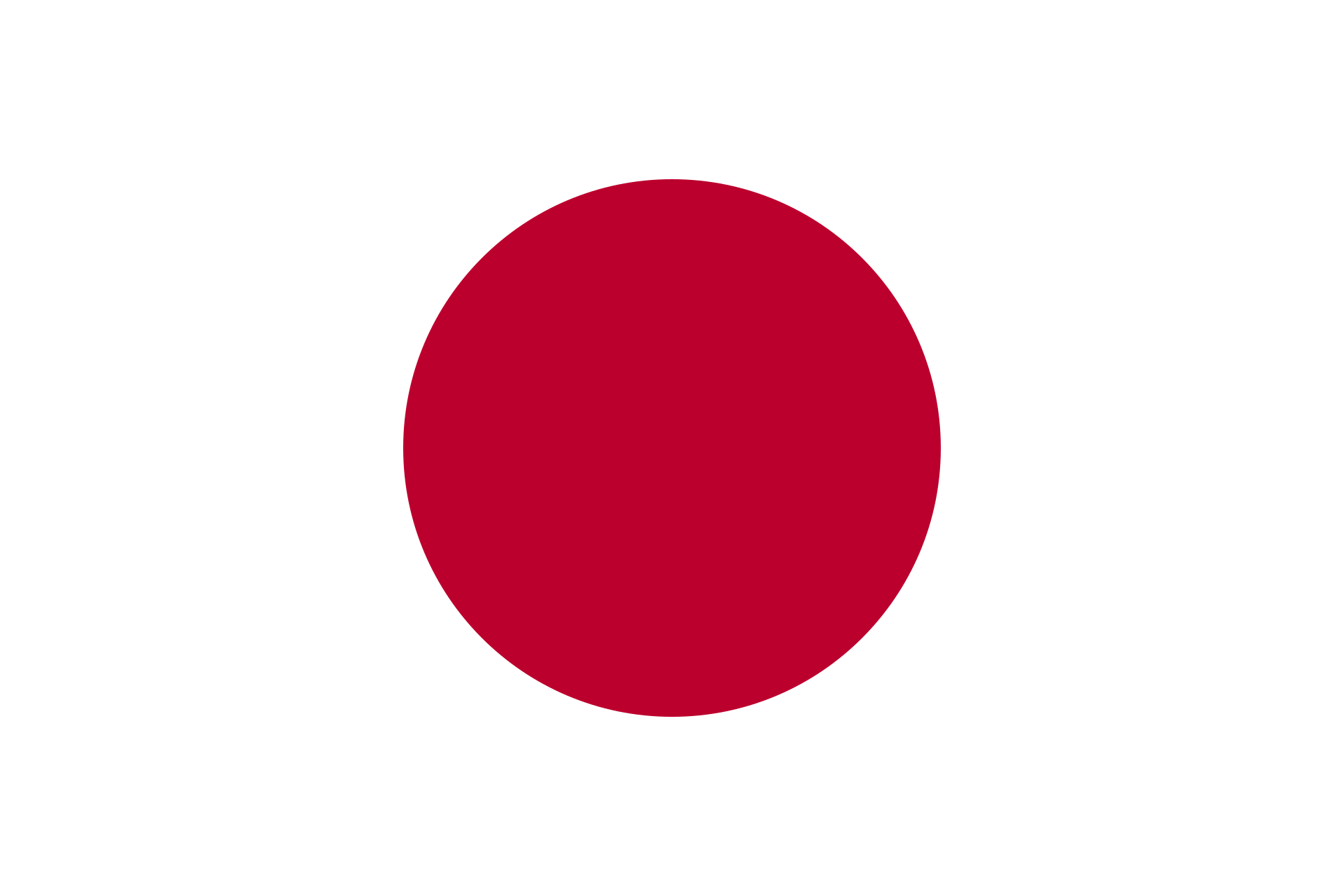
Above: Flag of Japan
Ferguson joined the Japan English Teaching (JET) programme in the early 1990s and lived in Kyushu for five years teaching English.
He married Terumi in Kumamoto, Japan in 1995.
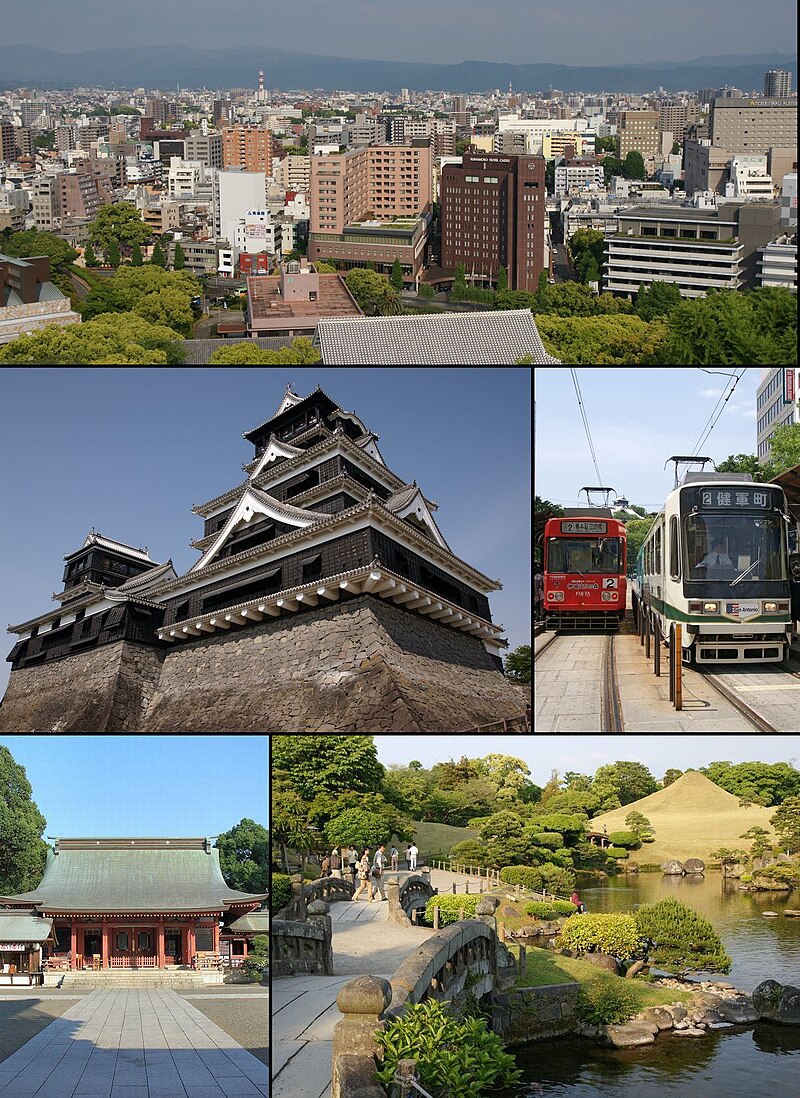
Above: Images of Kumamoto
After coming back from Japan he experienced a severe reverse culture shock, which became the basis for his first book Why I Hate Canadians (also the first of his books I have read).

He details his experiences hitchhiking across Japan in Hokkaido Highway Blues, later retitled Hitching Rides with Buddha.

He currently resides in Calgary (Alberta, Canada) with his wife and two sons.

Above: Downtown Calgary
To his co-workers at Starbucks Marktgasse St. Gallen (where we met and where I once worked for five years), Momo’s desire to return to and live in Japan seems outlandish, for even if the present crew at the store (Mexican boss, Mexican shift manager, two Canadians, four Swiss and one German) find Switzerland to be different from North America, Japan by comparison seems downright alien.
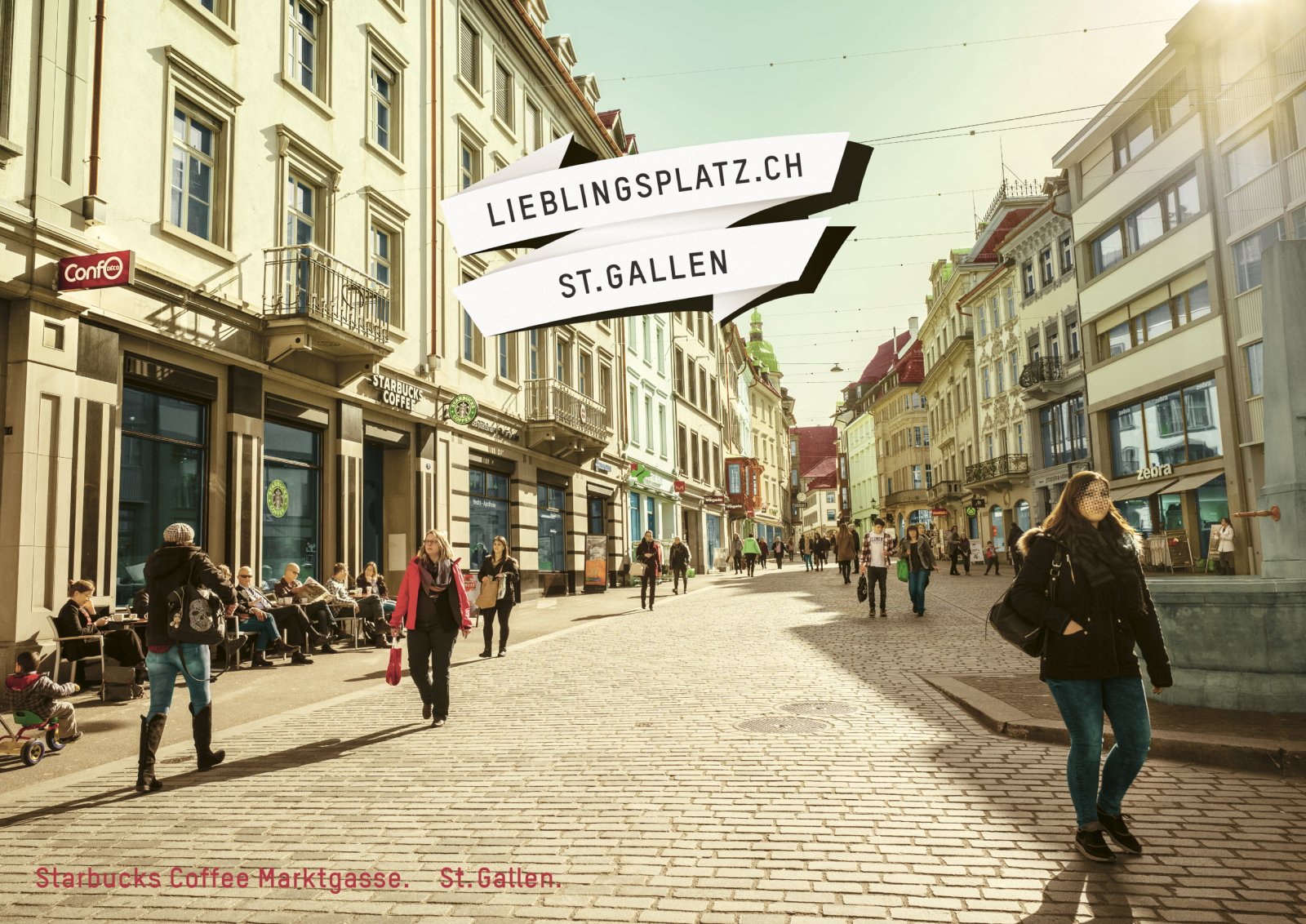
With the same fervour that Momo has for fashion in Japan and the enthusiasm that the Japanese have for outlandish game shows and tiny gadgets, the Japanese go nuts each spring when the cherry blossom sweeps from island to island towards the country’s northern tip – Hokkaido.
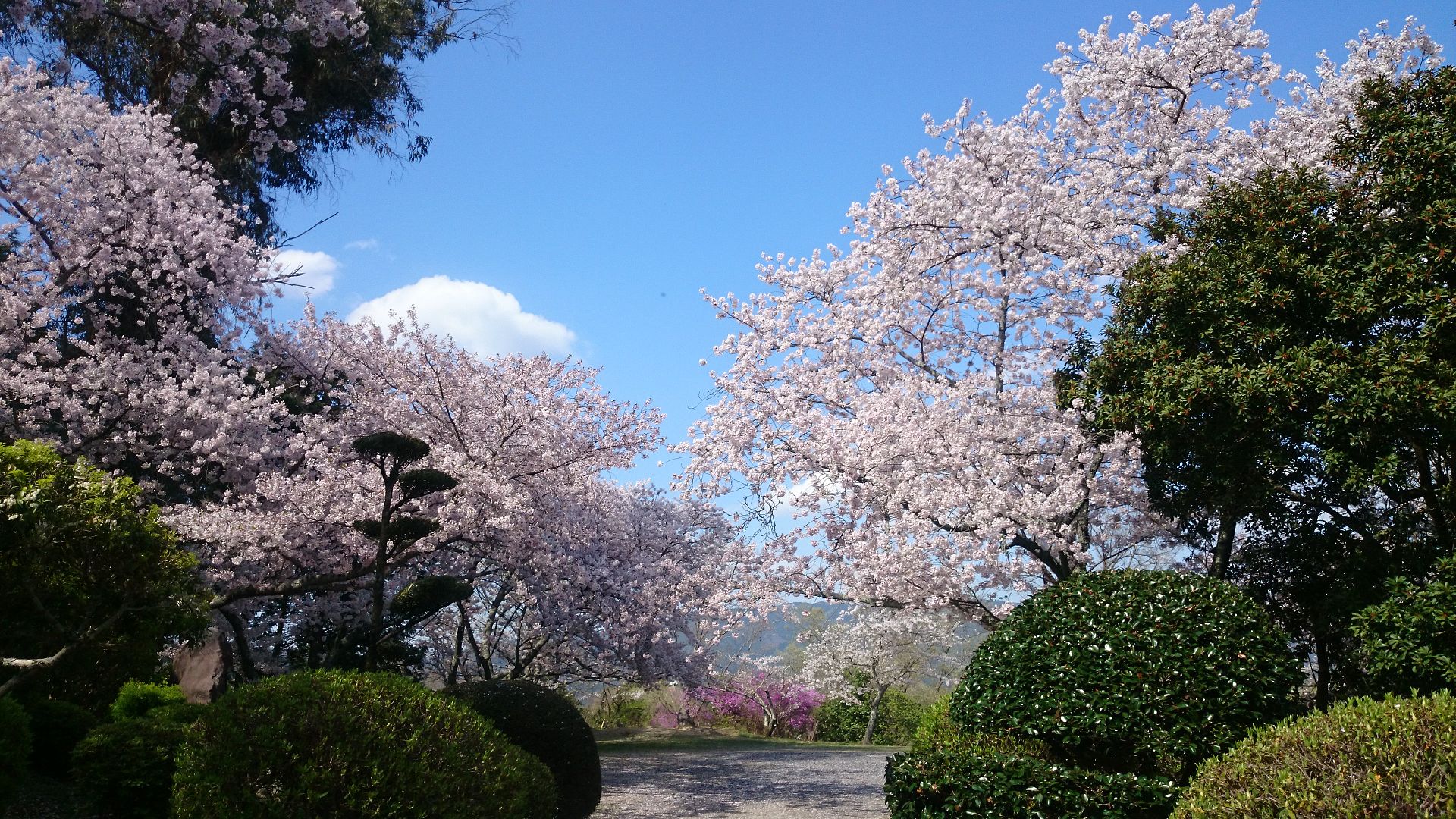
Ferguson was celebrating the event in the standard fashion.
After too much saké, he announced that he would be the first person in recorded history to follow the bloom’s progress.
To make it a challenge worth doing he would hitchhike all the way, relying on the kindness of strangers weird and wonderful.

Ferguson hitched north from Cape Sata (Kyushu) to Cape Soya (Hokkaido) in the first half of the 1990s.
Momo drove south from Tokyo (Honshu) to Fukuoka (Kyushu) in April 2019.
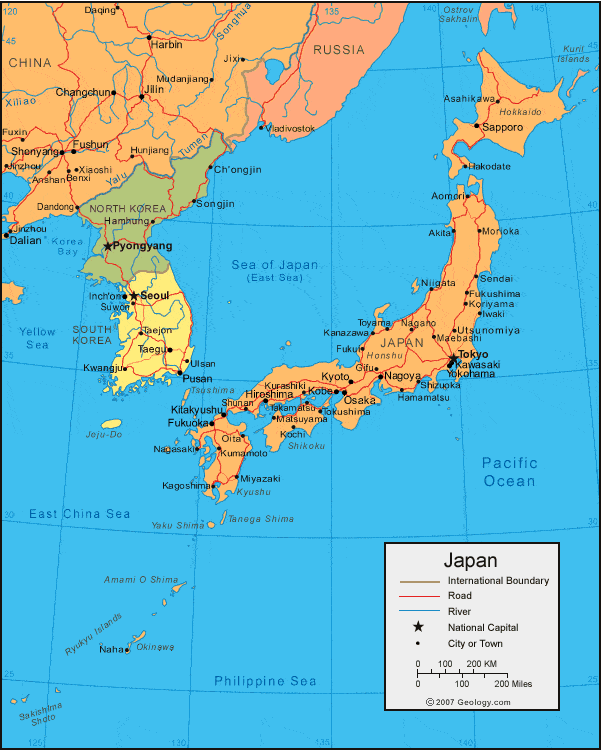
Arduous solo travel has a long history in Japan and Ferguson and Momo followed this proud tradition.
The mendicant poet Matsuo Basho (1644 – 1694) wandered the highways of the deep north in the late 17th century and wrote a classic travel narrative about it.
Basho was the most famous poet of the Edo period in Japan.
During his lifetime, Bashō was recognized for his works in the collaborative haikai no renga form.
Today, after centuries of commentary, he is recognized as the greatest master of haiku (hokku).
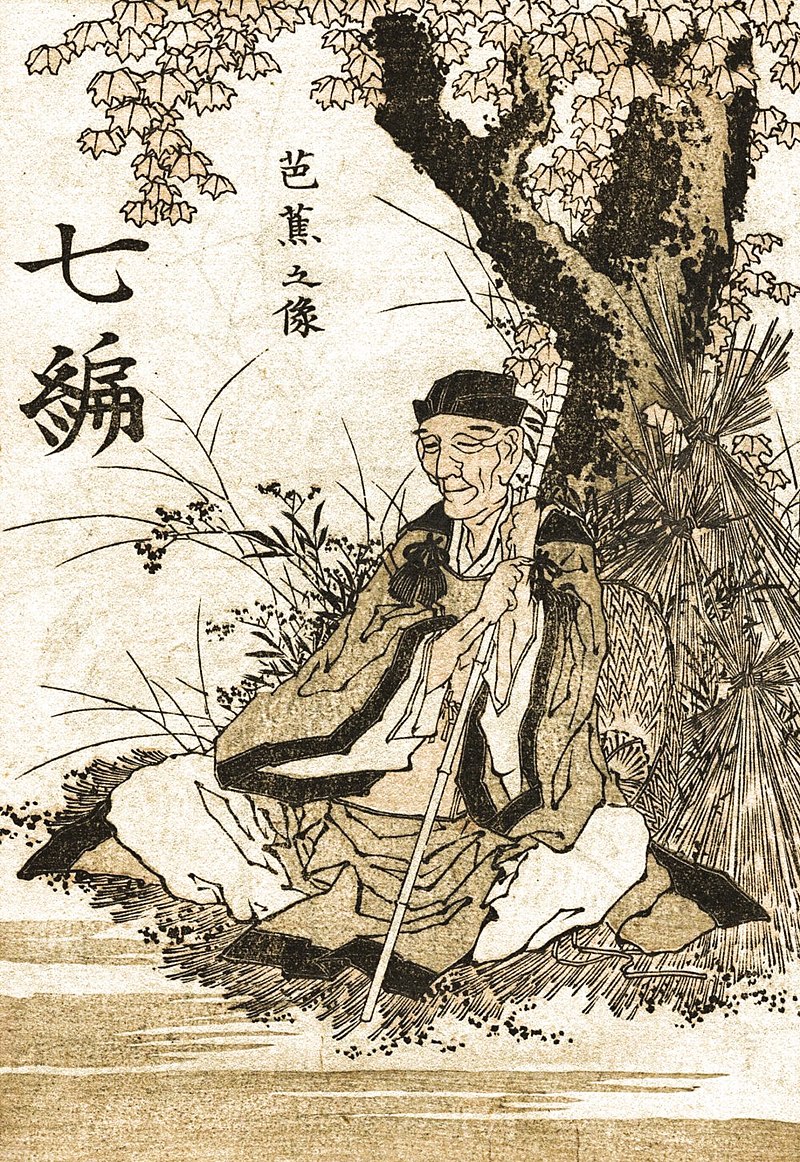
He is also well known for his travel essays beginning with “Records of a Weather-Exposed Skeleton” (1684), written after his journey west to Kyoto and Nara.
Matsuo Bashō’s poetry is internationally renowned, and, in Japan, many of his poems are reproduced on monuments and traditional sites.
Although Bashō is justifiably famous in the West for his hokku, he himself believed his best work lay in leading and participating in renku.
He is quoted as saying:
“Many of my followers can write hokku as well as I can.
Where I show who I really am is in linking haikai verses.“
Bashō was introduced to poetry at a young age, and after integrating himself into the intellectual scene of Edo (modern Tokyo) he quickly became well known throughout Japan.
He made a living as a teacher, but then renounced the social, urban life of the literary circles and was inclined to wander throughout the country, heading west, east, and far into the northern wilderness to gain inspiration for his writing.
His poems were influenced by his firsthand experience of the world around him, often encapsulating the feeling of a scene in a few simple elements.
Bashō traveled alone, off the beaten path, that is, on the Edo Five Routes, which in medieval Japan were regarded as immensely dangerous.
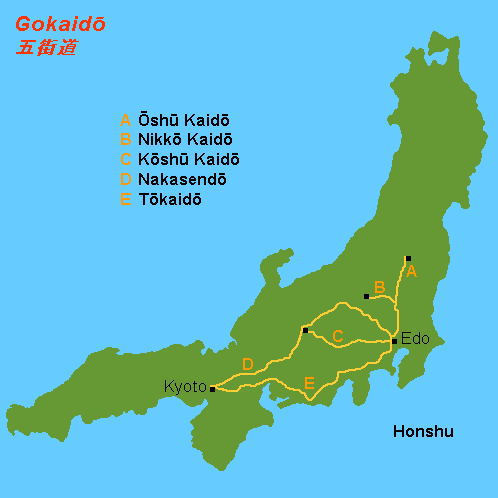
Above: The Edo Five Routes
At first Bashō expected to simply die in the middle of nowhere or be killed by bandits.
However, as his trip progressed, his mood improved, and he became comfortable on the road.
Bashō met many friends and grew to enjoy the changing scenery and the seasons.
His poems took on a less introspective and more striking tone as he observed the world around him:
馬をさへながむる雪の朝哉 uma wo sae / nagamuru yuki no / ashita kana
Even a horse / arrests my eyes—on this / snowy morrow. [1684]
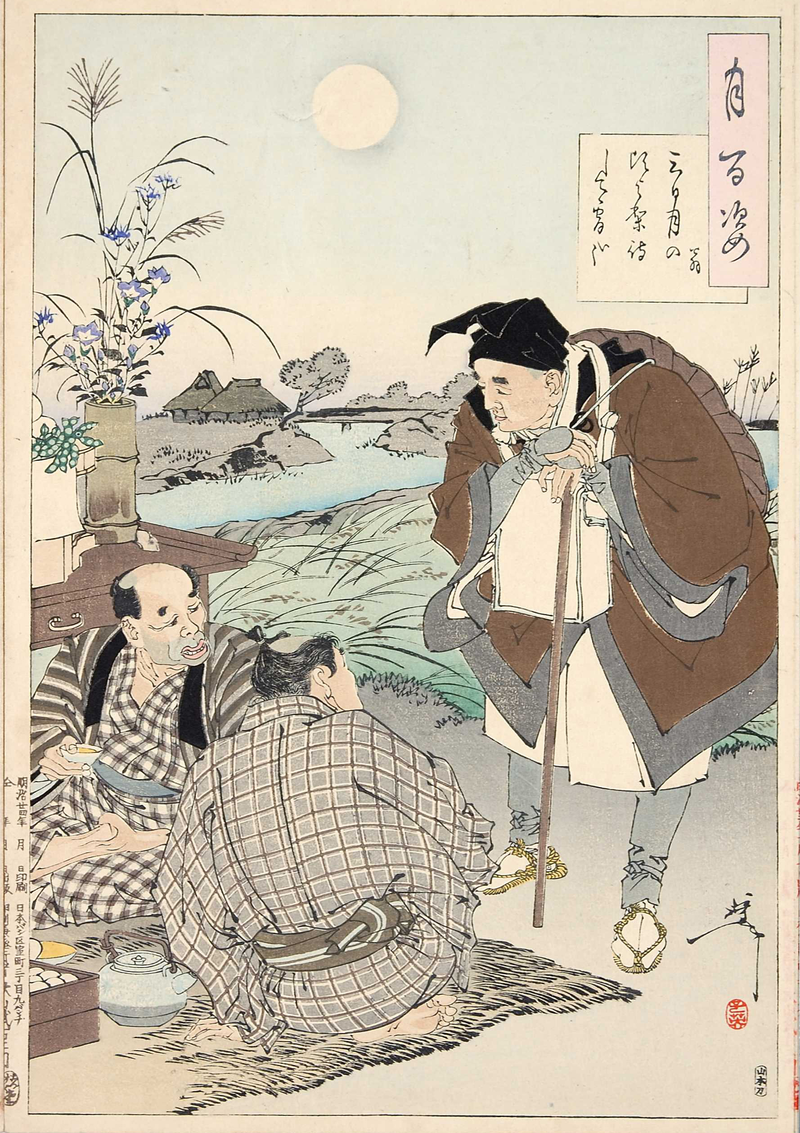
Above: Bashō meets two farmers celebrating the mid-autumn moon festival in a print from Yoshitoshi’s Hundred Aspects of the Moon.
The haiku reads: “Since the crescent moon, I have been waiting for tonight.“
The trip took him from Edo to Mount Fuji, Ueno, and Kyoto.

Above: “Bashō’s Hermitage and Camellia Hill on the Kanda Aqueduct at Sekiguchi” from Hiroshige’s One Hundred Famous Views of Edo

Above: Mount Fuji

Above: Iga-Ueno Castle, Ueno, Mie
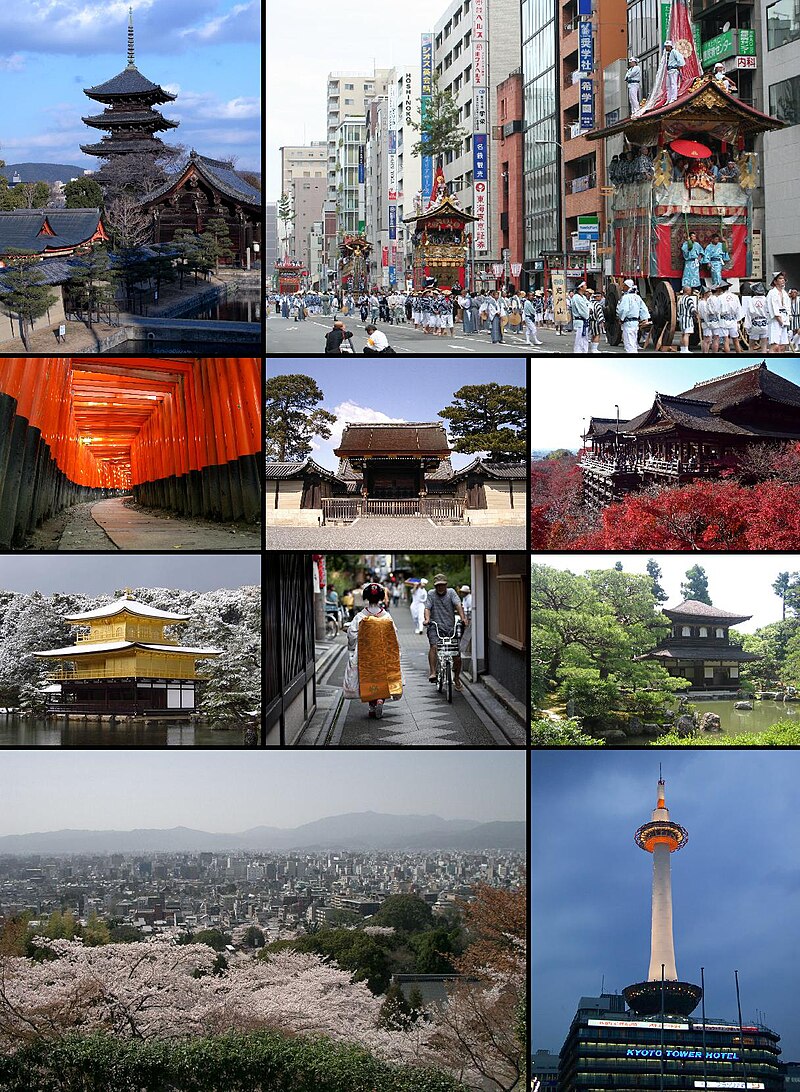
Above: Images of modern Kyoto
Basho met several poets who called themselves his disciples and wanted his advice.
He told them to disregard the contemporary Edo style and even his own Shriveled Chestnuts, (the title of his work, not a description of his anatomy) saying it contained “many verses that are not worth discussing“.
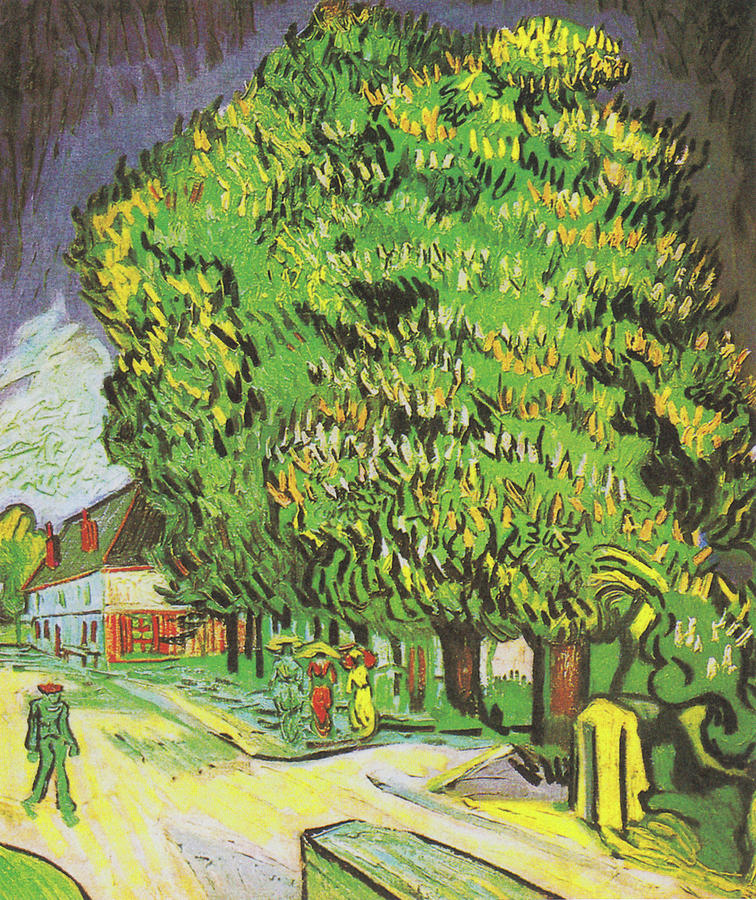
Bashō returned to Edo in the summer of 1685, taking time along the way to write more hokku and comment on his own life:
年暮ぬ笠きて草鞋はきながら toshi kurenu / kasa kite waraji / hakinagara
Another year is gone / a traveller’s shade on my head, / straw sandals at my feet. [1685]
When Bashō returned to Edo he happily resumed his job as a teacher of poetry at his hut, although privately he was already making plans for another journey.
The poems from his journey were published as Account of Exposure to the Fields (野ざらし紀行, Nozarashi kikō).
In early 1686 he composed one of his best-remembered haiku:
古池や蛙飛びこむ水の音 furu ike ya / kawazu tobikomu / mizu no oto
An ancient pond / a frog jumps in / the splash of water. [1686]

Bashō’s private planning for another long journey, to be described in his masterwork Oku no Hosomichi, or The Narrow Road to the Deep North, culminated on 16 May 1689 (Yayoi 27, Genroku 2), when he left Edo with his student and apprentice Kawai Sora on a journey to the Northern Provinces of Honshu.
Bashō and Sora headed north to Hiraizumi, which they reached on 29 June.
They then walked to the western side of the island, touring Kisakata on 30 July, and began hiking back at a leisurely pace along the coastline.
During this 150-day journey Bashō traveled a total of 600 ri (2,400 km) through the northeastern areas of Honshū, returning to Edo in late 1691.
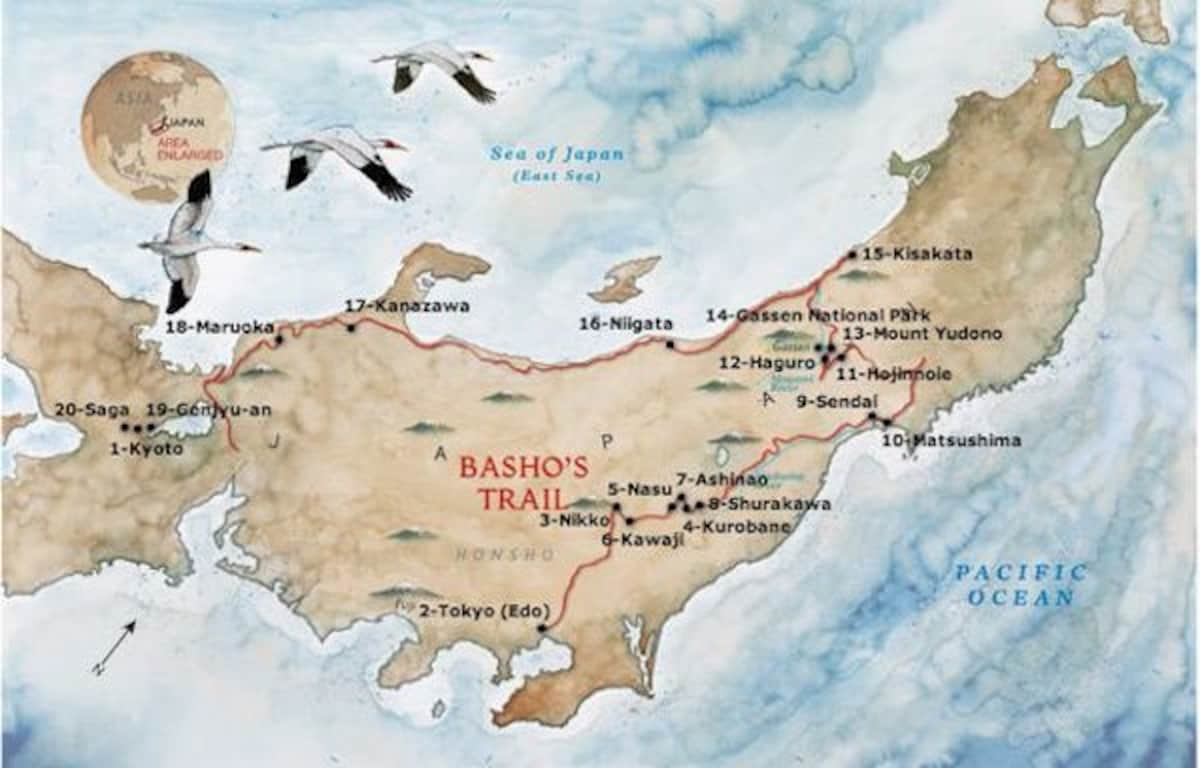
By the time Bashō reached Ogaki, Gifu Prefecture, he had completed the log of his journey.
He edited and redacted it for three years, writing the final version in 1694 as The Narrow Road to the Interior (奥の細道, Oku no Hosomichi).
The first edition was published posthumously in 1702.
The text is written in the form of a prose and verse travel diary and was penned as Bashō made an epic and dangerous journey on foot through the Edo Japan of the late 17th century.
While the poetic work became seminal of its own account, the poet’s travels in the text have since inspired many people to follow in his footsteps and trace his journey for themselves.
In one of its most memorable passages, Bashō suggests that “every day is a journey, and the journey itself home”.
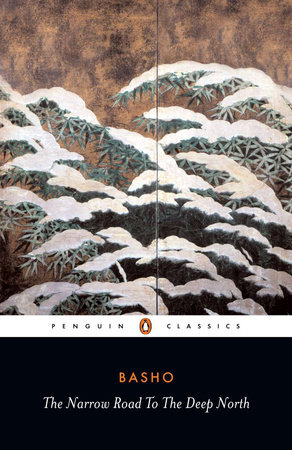
Of Oku no Hosomichi, Japanese novelist and poet Kenji Miyazawa (1896 – 1933) once suggested:
“It was as if the very soul of Japan had itself written it.”
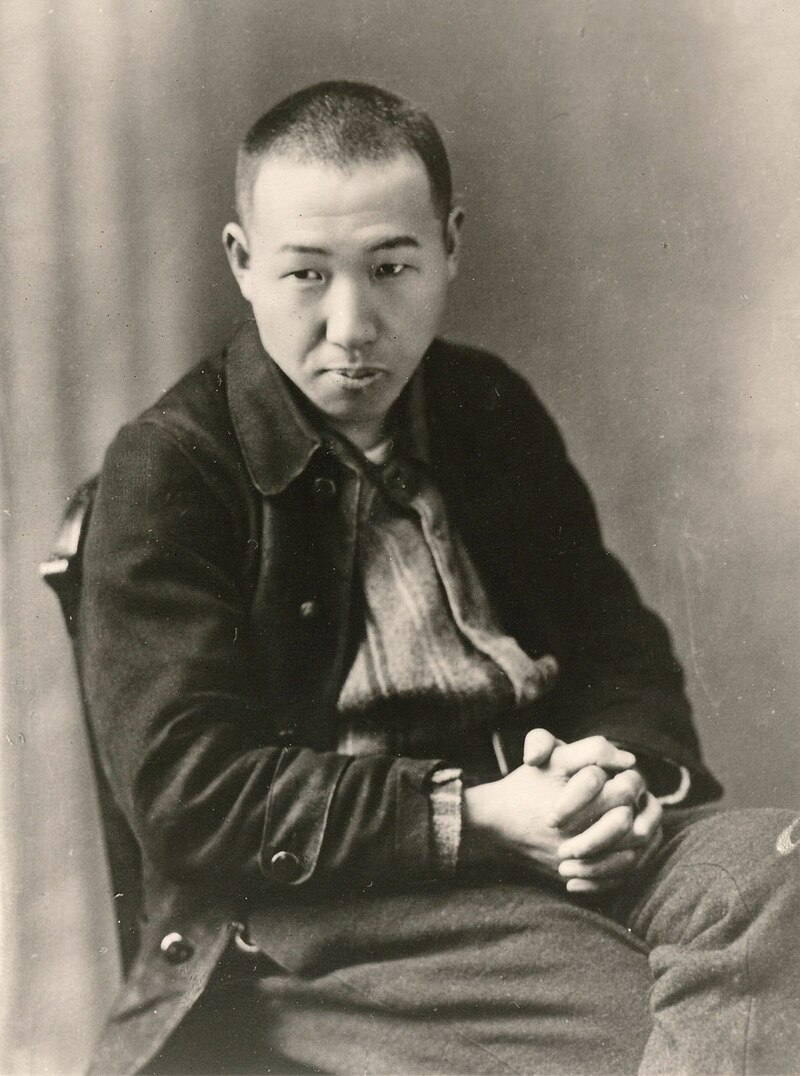
Above: Kenji Miyazawa
It was an immediate commercial success and many other itinerant poets followed the path of his journey.
It is often considered his finest achievement, featuring hokku such as:
荒海や佐渡によこたふ天河 araumi ya / Sado ni yokotau / amanogawa
The rough sea / stretching out towards Sado / the Milky Way. [1689]

How it begins (English translation):
The months and days are the travellers of eternity.
The years that come and go are also voyagers.
Those who float away their lives on ships or who grow old leading horses are forever journeying, and their homes are wherever their travels take them.
Many of the men of old died on the road, and I too for years past have been stirred by the sight of a solitary cloud drifting with the wind to ceaseless thoughts of roaming.
Last year I spent wandering along the seacoast.
In autumn I returned to my cottage on the river and swept away the cobwebs.
Gradually the year drew to its close.
When spring came and there was mist in the air, I thought of crossing the Barrier of Shirakawa into Oku.

Above: Shirakawa Barrier
I seemed to be possessed by the spirits of wanderlust, and they all but deprived me of my senses.
The guardian spirits of the road beckoned, and I could not settle down to work.
I patched my torn trousers and changed the cord on my bamboo hat.
To strengthen my legs for the journey I had moxa burned on my shins.
By then I could think of nothing but the moon at Matsushima.
When I sold my cottage and moved to Sampū’s villa, to stay until I started on my journey, I hung this poem on a post in my hut:
| kusa no to mo sumikawaru yo zo hina no ie | Even a thatched hut May change with a new owner Into a doll’s house. |
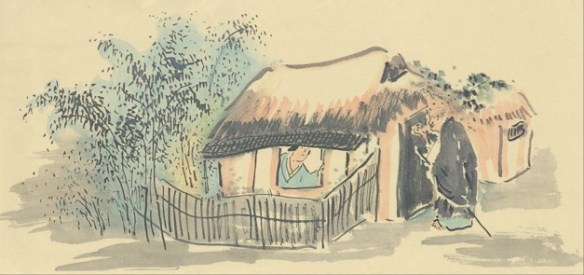
Three hundred years after Basho, an Englishwoman, Lesley Downer, retraced his footsteps and wrote of her journey in On the Narrow Road to the Deep North: Journey into a Lost Japan.
Walking and hitchhiking towards the Sacred Mountains with their legendary priests, meeting people who had never before seen a westerner and dining on flowers and sautéed grasshoppers, she found herself in a world which many Japanese believe vanished centuries ago.
She stayed in farming villages, composed poems with the poets of a lonely northern town and finally she too arrived at the Sacred Mountains.
Rich in atmosphere and history, On the Narrow Road to the Deep North evokes both the chaos and concrete of the new Japan and the simple aesthetic of the old.
It is one of those rare books that provide a window into a vanished world.
On the Narrow Road to the Deep North was filmed by Channel 4 and WNET as ‘Journey to a Lost Japan’.
It was the basis for a film by NHK, the Japanese national broadcasting corporation, entitled ‘Journey of the Heart.’
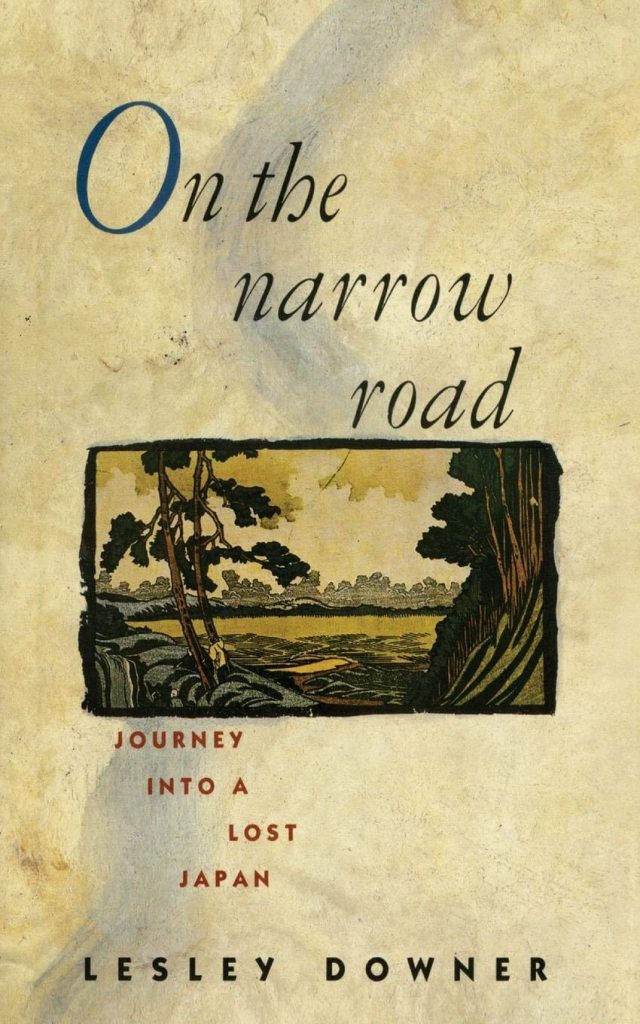
In 1980, Alan Booth (1946 – 1993) walked the entire length of Japan, north to south, and wrote a travel narrative of his own.
Booth wrote two books about his journeys on foot through the Japanese countryside.
The better-known of the two, The Roads to Sata, published in 1985, is about his travels in 1977 from Cape Soya, the northern tip of Hokkaido, to Cape Sata, the southern tip of Kyushu.

The second, Looking for the Lost, was published posthumously in 1995.

Booth also wrote a guidebook to Japan, as well as numerous articles on Japan and other topics.

I particularly like Booth’s forward to The Roads to Sata:
“Japan is a long country.
If I had walked the same distance across the same latitude in North America, the trek would have taken me from Ottawa, Ontario, to Mobile, Alabama.
If I had started in Europe, I would have marched from Belgrade throught the Middle East to the Gulf of Aquaba….
I have tried to avoid generalizations, particularly “the Japanese”.
“The Japanese” are 120 million people, ranging in age from 0 to 119, in geographical locations across 21° of latitude, 23° of longititude, and in profession from Emperor to urban guerilla.
This book is about my encounters with 1,200 businessmen, farmers, grandmothers, fishermen, housewives, shopkeepers, schoolchildren, soldiers, policemen, monks, priests, tourists, journalists, professors, labourers, maids, waiters, carpenters, teachers, innkeepers, potters, dancers, cyclists, students, truck drivers, Koreans, Americans, bar hostesses, professional wrestlers, government officials, hermits, drunks and tramps.“

Ferguson believed the ways that Basho, Downer and Booth were solitary ways to see the country.
Ferguson didn’t want to travel among the Japanese.
He wanted to travel with the Japanese.
Ferguson didn’t want to walk Japan, as Alan Booth had done, precisely because it is such a lonely, aloof way to travel.
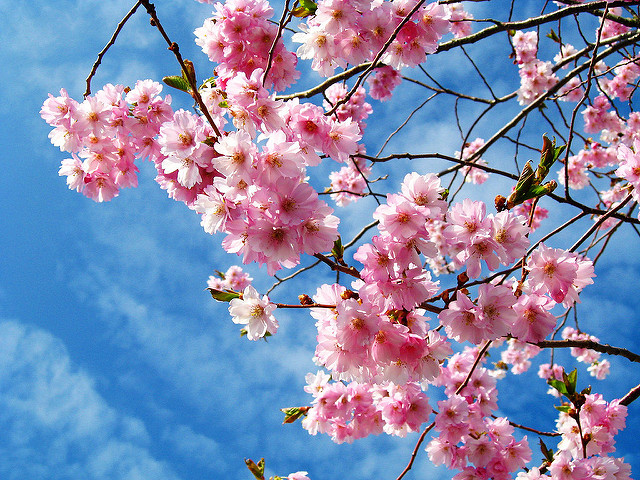
(Here I disagree with Ferguson:
A walker is as alone and aloof as he chooses to be.)

Also Ferguson was not thrilled with the notion of a lot of walking.
Personally, Ferguson preferred zipping along in an air-conditioned car.
Tramping down a highway all day long often put Booth in a sour mood, but Ferguson felt that when you are constantly prevailing on the kindness of strangers – as a hitchhiker must – it keeps you in a positve frame of mind.
“Call it ‘Zen and the Art of Hitchhiking’, ‘the Way of the Lift’, the Chrysanthemum and the Thumb’“.

Momo travelled in an air-conditioned car.
To be fair to Momo, the two things a traveller needs to make a “journey” rather than simply a “trip” are time and money.
Neither of which were in Momo’s favour.
He had two weeks remaining from his month sojourn in Japan and much money had already been spent in the first two weeks in Tokyo.

Above: Tokyo
Again, to be fair to Momo, as advantageous as public transport is in Japan, its very convenience detracts from the experience of the country.
The Japanese Bullet Train – the Shinkansen – completed just before the Tokyo Olympics in 1964, has been running 150 mph every 20 minutes since then.

As well as the now-privatised Japan National Railways, there are dozens of smaller regional private railways.

Many of them own large department stores placed handily next to the big stations.
One need never read the timetable because trains in Japan are very frequent and scarcely ever late.
Nearly all tickets are sold from machines, but because place names are so difficult to read that often the only people who will understand them are the locals, those from outside the area need assistance.

Every station has a constant stream of recorded announcements in Japanese, either:
- ones with a jingle (train announcements)
- ones without (general announcements, such as “Thank you for your honourable custom.“, “Be kind to the elderly and disabled.“, “Please do not try to board a train which is full.”, and so on.)
Commuter trains in Japan are full of men in blue suits and spectacles, tightly squeezed because railway staff push people on board to make sure that the trains are running nicely full.
This is not entirely necessary for, despite their extreme politeness to anyone they meet, at peak times on a train it is everyone for himself.
Inside, in winter, everyone’s spectacles steam up, but since they can’t work their arms free to wipe them, they are temporarily blinded and (if they have not been keeping track o the announcements), they have to keep asking each other which station they have come to.

Buses have even more persistent recorded announcements and advertisements on board.
Throughout the journey, passenger are treated to an unceasing commentary:
“The next stop is the Hospital, which is also handy for Fukuda’s Contact Lens Centre.
After that the next stop will be the Station.
Thank you for your honourable custom.
Please be nice to old people.
Next stop, the Hospital.
Those wishing to visit Yamamoto’s Ear Clinic should honourably alight here.
Please be considerate to disabled people.
Please mind the doors.
Please do not bump your head as you get up.
The bus has air brakes and the driver may find it necessary to humbly stop the bus abruptly, so we entreat your esteemed caution.
Hospital, this is the Hospital.
Next stop is the Station, which is convenient for the Gynaecologist’s.
Thank you for your honourable custom….“

Perhaps the high rate of suicides in Japan begins here?
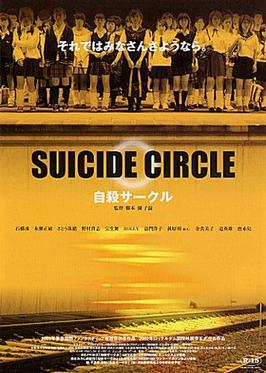
Fortunately, Momo has a friend (of many) in Japan.
Fortunately, Momo was in Japan in April.
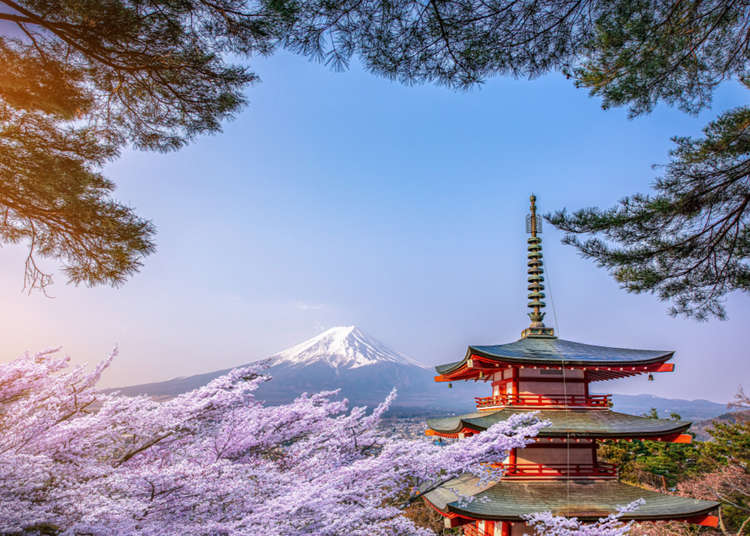
Every spring, a wave of flowers sweeps across Japan,
It begins in Okinawa and rolls from island to island to mainland.
It hits the mainland at Cape Sata and moves north, cresting as it goes, to the very tip of distant Hokkaido, where it scatters and falls into a northern sea.

They call it Sakura Zensen – the Cherry Blossom Front – and its advance is tracked with a seriousness usually reserved for armies on the march.
Progress reports are given nightly on the news and elaborate maps are prepared to show the front lines, the back lines, and the percentage of blossoms in any one area.
“In Shimabara today they reported 37% full blossoms.”

Nowhere on Earth does spring arrive as dramatically as it does in Japan.
When the cherry blossoms hit, they hit like a hurricane.
Gnarled cherry trees, ignored for most of the year, burst into bloom like fountains turned suddenly on.
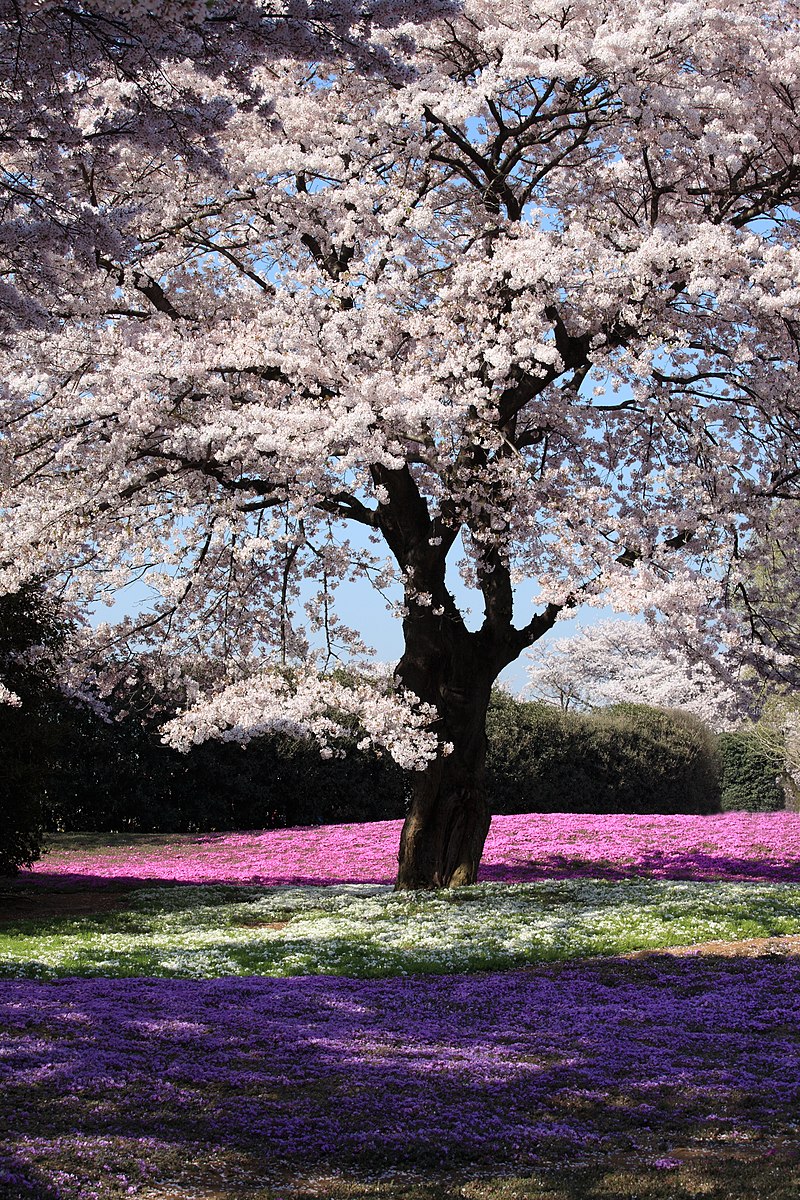
The coming of the sakura marks the end of winter.
It also marks the start of the school year and the closing of the business cycle.
It is a hectic time, a time of final exams and productivitiy reports.
Budgets have to be finalized, accounts settled, work finished.
Karoshi (death by overwork) peaks in March.
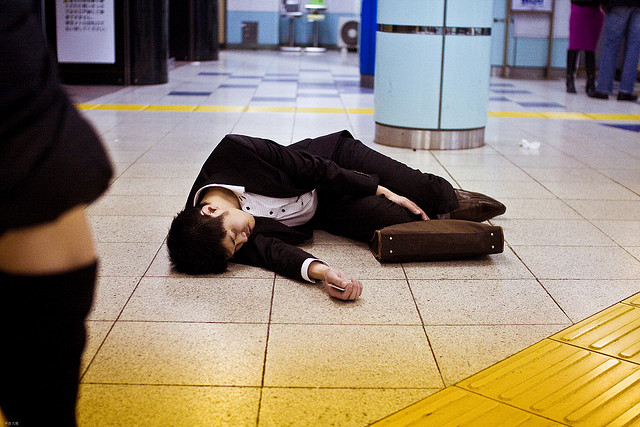
Deadlines, school graduations, government transfers – and then, riding in on April winds, come the cherry blossoms.
And in one of those extreme shifts that seem to mark Japanese life, the nation swings from intense work to intense play.
Crowds congregate the flowers.
Saké flows.
Neckties are loosened.
Wild spontaneous haiku are composed and recited.

These cherry blossom parties, called hanami, are a time for looking back and looking ahead, for drowning one’s sorrows or celebrating another successful year.
Toasts are made to colleagues, absent friends, distant relatives, and to the sakura themselves.
Then, as quickly as they arrrive, the cherry blossoms scatter.
They fall like confetti.
In their passing they leave the dark shimmering heat of summer, the wet misery of the rainy season, the typhoons of late August.
At their peak – at full blossom and full beauty – the sakura last only a few days.

During their brief explosion, the cherry blossoms are said to represent the aesthetics of poignant, fleeting beauty: ephermeral, delicate in their passing.
The way to celebrate this poignancy, naturally, is to drink large amounts of saké and sing raucous songs until you topple over backward.
It is all very fleeting and beautiful.
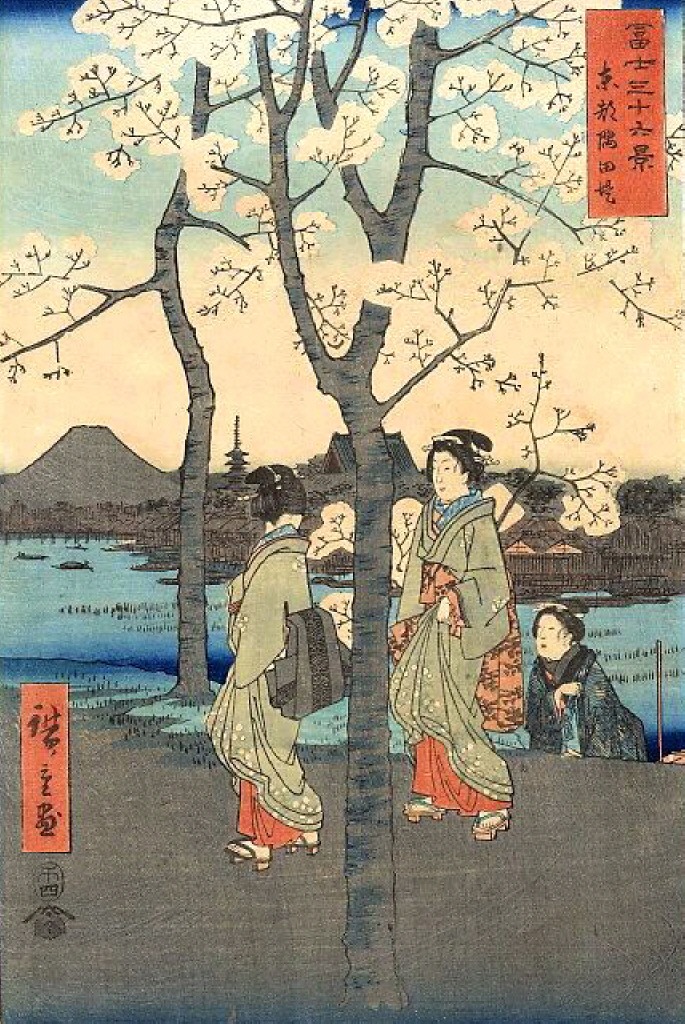
It is also oddly formalized.
In what other nation would you find a memo posted on a company’s cafeteria noticeboard that reads:
KEEP THE AREA CLEAN.
FINAL REPORTS ARE DUE FRIDAY, AND, DON’T FORGET, WE ARE GOING CHERRY BLOSSOM VIEWING AFTER WORK TODAY.
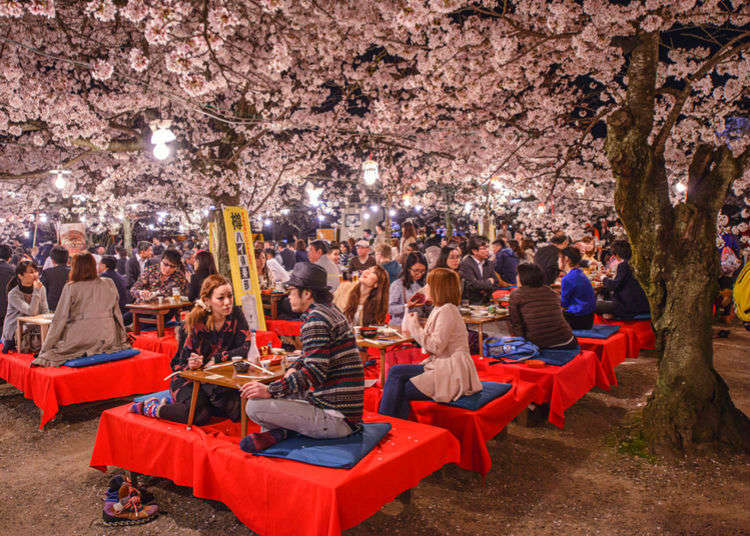
In addition to the usual public parks and castle grounds, cemeteries are sometimes chosen as suitable spots for cherry blossom parties – as a counterpoint to the celebrations, and as a reminder that this beauty, this joy, like all things will pass.
We live in a world of impermanence, a world of flux and illusion, a world brimming with sadness – so we might as well get pissed and enjoy ourselves.
(Eat, drink and be merry, for tomorrow we die.)

In the late 19th century, a British scholar noted that if one could just reconcile the lofty heights of Japanese ideals with the earthy limitations of its people, one would truly understand the essence of this beguiling nation.

It was an invitation from a friend that prompted Momo’s explorations of a city, of a place other than Tokyo.
A car is rented and a long drive begins.
1,100 km / 684 miles / 14.5 hours separates Tokyo from Fukuoka.

Japan is not a small country, no matter what the Japanese themselves may think.
The main island of Honshu alone is larger than Great Britain.

Were Japan in Europe, it would dominate the Continent.
Japan is larger than Italy, than Norway, than Germany.

A journey from Cape Sata in the south to Cape Soya at the north covers 3,000 kilometers.
In North America this would be a journey from Miami to Montréal – and at roughly the same latitudes.
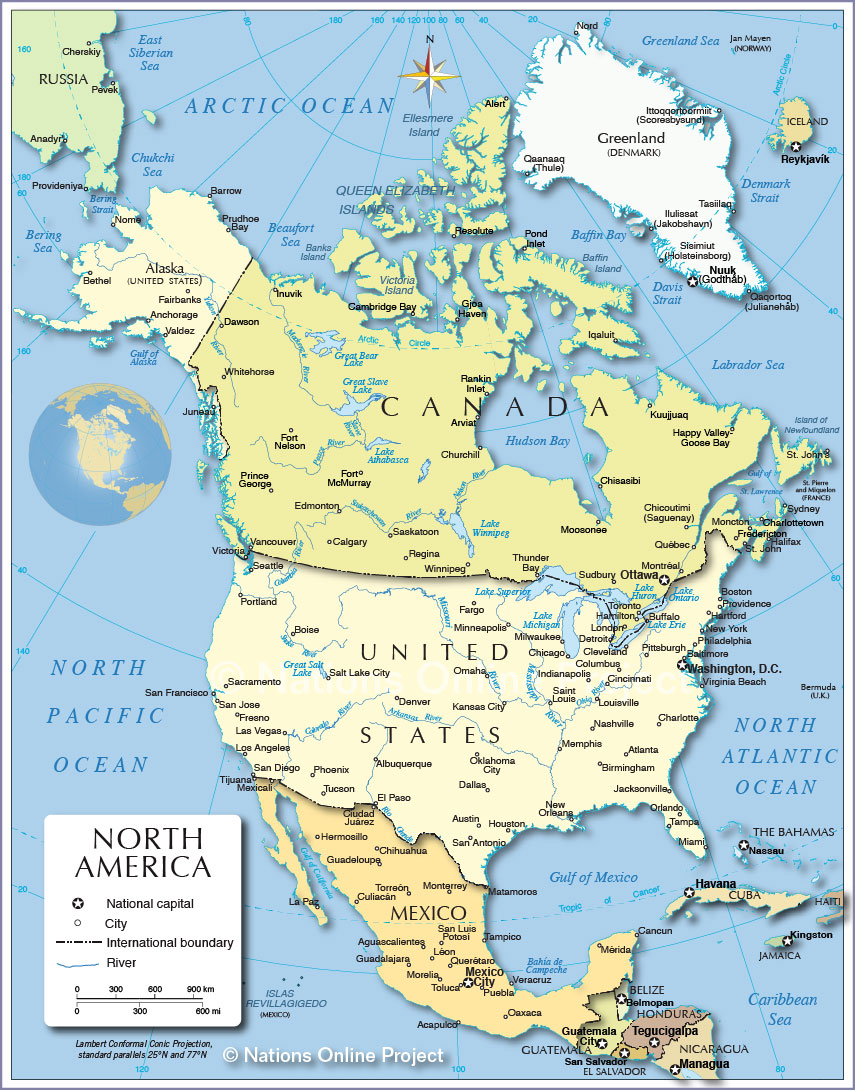
So why this persistent image that Japan is a tiny little place?
One reason is due to a cartographical optical illusion:
On a map, Japan looks small, because it is surrounded by the largest nations on Earth: China, Russia, Canada, the United States and Australia.
But there is more involved than this.
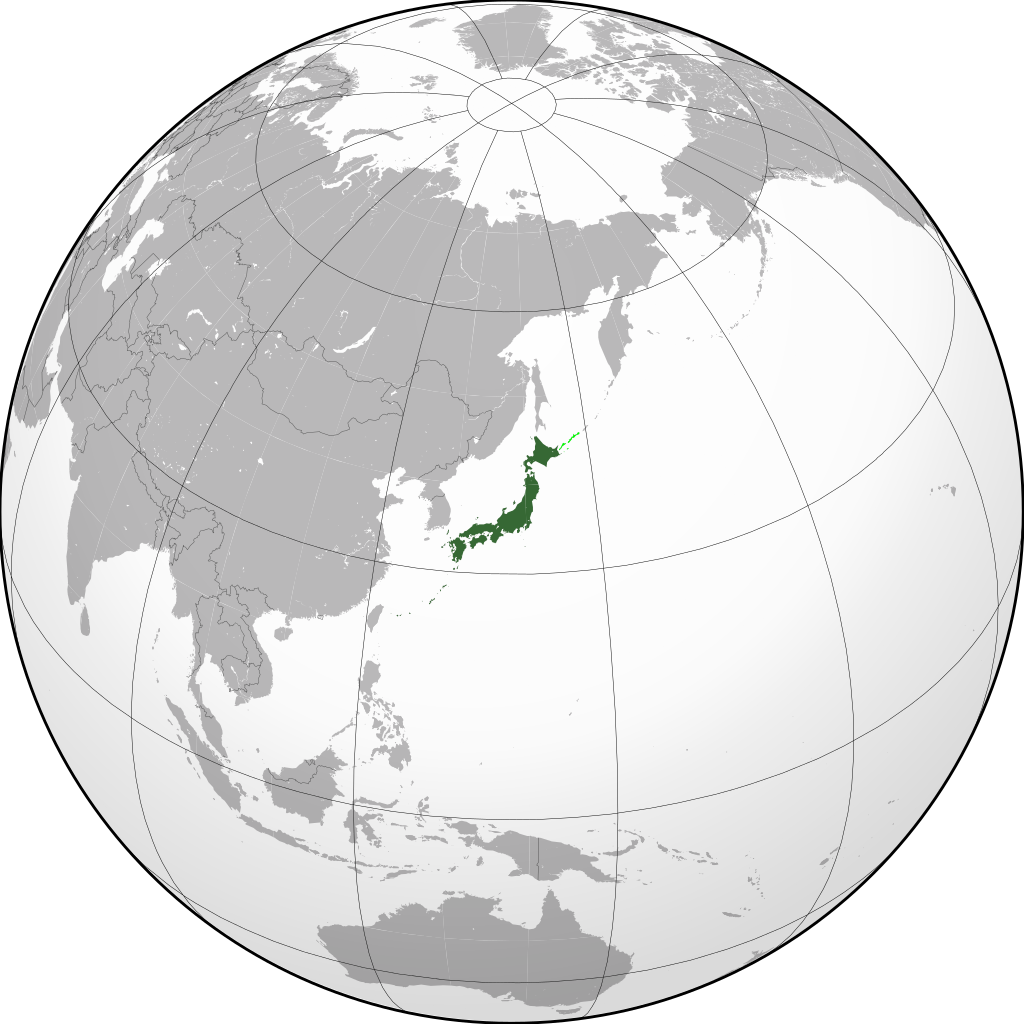
Japan is small, because Japan prefers it this way.
It supports the image Japan has of itself: the beleaguered underdog, small but mighty, the little engine that could.

If you tell the average Japanese person that their country has a larger population base and a far bigger land mass than that of Great Britain, they will either resent it or refuse to believe you.

Oddly enough, despite their conviction that they live in a small country, the Japanese Momo knew in Tokyo, thought of Fukuoka as being hopelessly remote.

Above: Images of Fukuoka
Momo no longer remembers where or even if his journey was broken mid-distance.
But he remembers fondly his two weeks on Kyushu, mostly based in Fukuoka.

Fukuoka (福岡市, Fukuoka-shi) is the capital city of Fukuoka Prefecture, situated on the northern shore of the Japanese island of Kyushu.
It is the most populous city on the island.
Greater Fukuoka, with a population of 2.5 million people (2005 census), is part of the heavily industrialized Fukuoka – Kitakyushu zone.
As of 2015, Fukuoka is Japan’s 6th largest city, having passed the population of Kobe.
In July 2011, Fukuoka surpassed the population of Kyoto.
Since the founding of Kyoto in 794, this marks the first time that a city west of the Kinki region has a larger population than Kyoto.
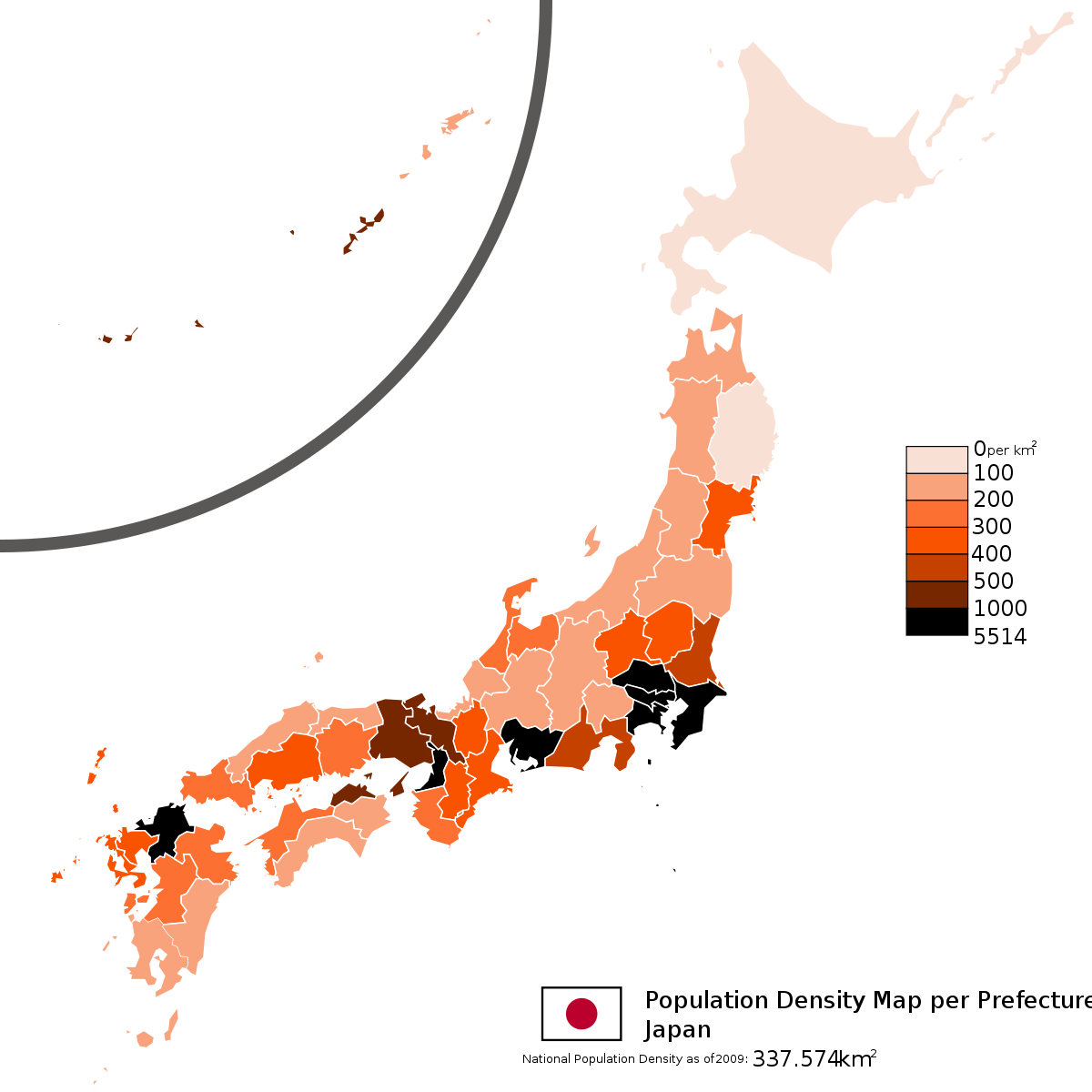
Fukuoka was sometimes called the Port of Dazaifu (大宰府), 15 km (9 mi) southeast from Fukuoka. Dazaifu was an administrative capital in 663, but a historian proposed that a prehistoric capital was in the area.
Ancient texts, such as the Kojiki, Kanyen (found in Dazaifu) and archaeology confirm this was a very critical place in the founding of Japan.

Some scholars claim that it was the first place outsiders and the Imperial Family set foot, but like many early Japan origin theories, it remains contested.
Central Fukuoka is sometimes still referred as Hakata, which is the name of the central ward.

Above: Bayside Place, Fukuoka
In 923, the Hakozaki-gu in Fukuoka was transferred from Daibu-gū in Daibu (大分), 16 km (10 mi) northeast from Dazaifu, the origin of Usa Shrine and established as a branch of the Usa Shrine at Fukuoka.
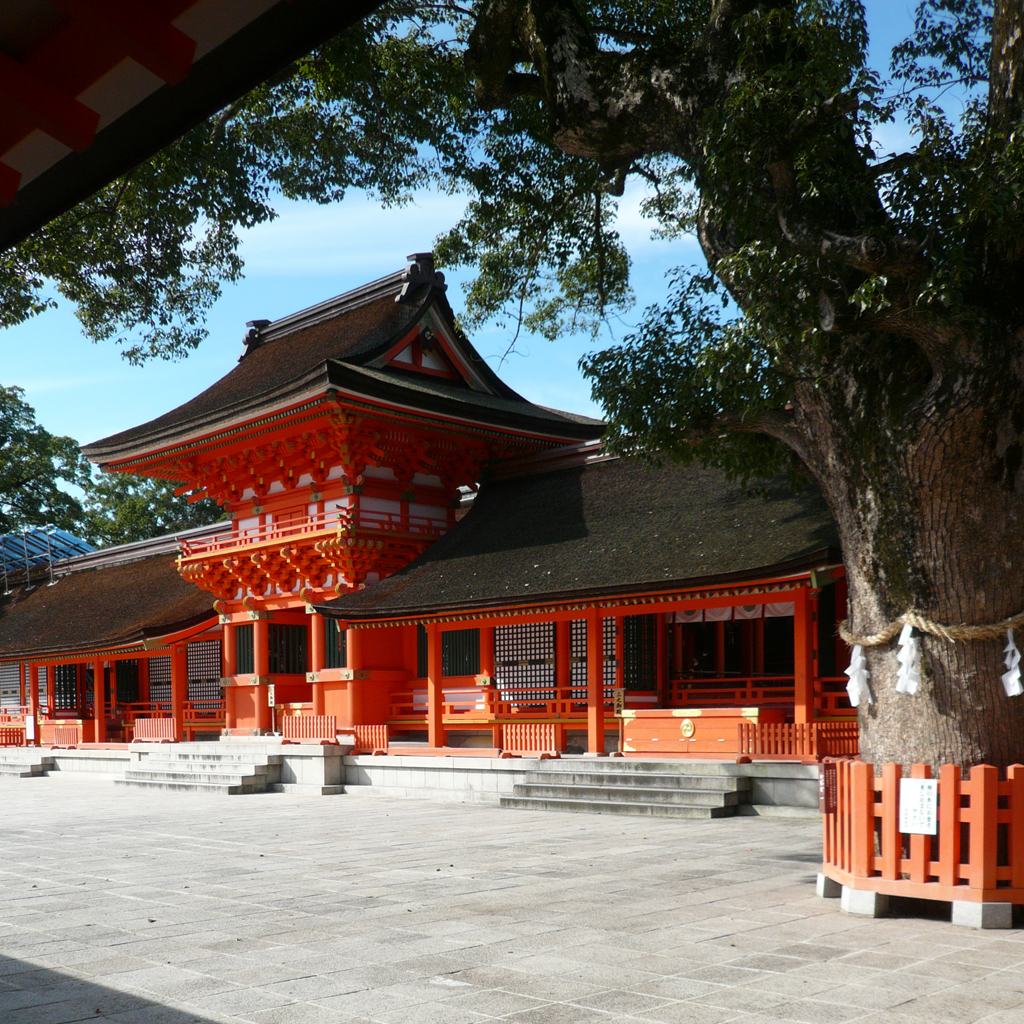
Above: Usa Shrine
In Ooho (大保), 15 km (9 mi) south from Dazaifu, there are remains of a big ward office with a temple, because in ancient East Asia, an emperor must have three great ministries (大宰, 大傳 and 大保).
In fact, there is a record in Chinese literature that a king of Japan sent a letter in 478 to ask the Chinese emperor’s approval for employing three ministries.
In addition, remains of the Korokan (鴻臚館, Government Guest House) were found in Fukuoka underneath a part of the ruins of Fukuoka Castle.

Above: Fukuoa Castle
Kublai Khan of the Mongol Empire turned his attention towards Japan starting in 1268, exerting a new external pressure on Japan with which it had no experience.
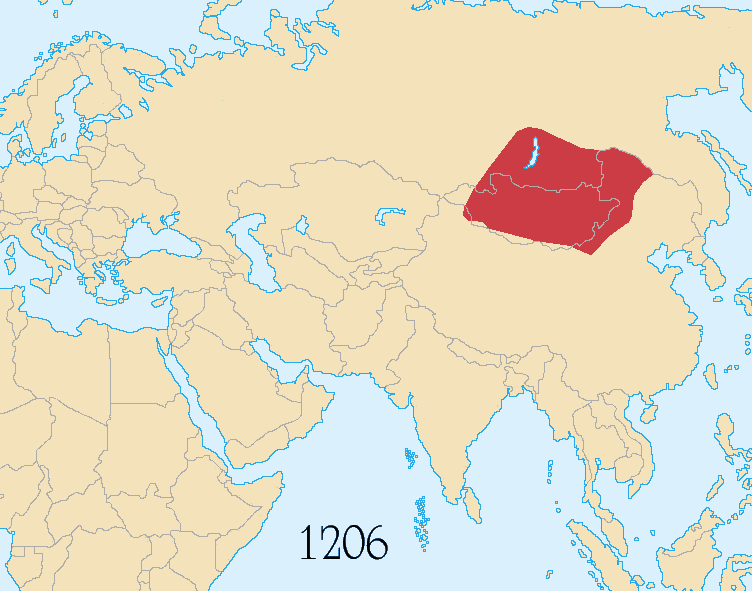
Above: Expansion of the Mongol Empire (1206 – 1294)
Kublai Khan first sent an envoy to Japan to make the Shogunate acknowledge Khan’s suzerainty.
The Kamakura shogunate refused.

Above: Portrait of Kublai Khan (1215 – 1294)
Mongolia repeatedly sent envoys thereafter, each time urging the Shogunate to accept their proposal, but to no avail.

Above: Rabban Bar Sauma (1220 – 1294), ambassador of the Great Kublai Khan, travelled from Mongolia to Rome, Tuscany, Genoa, Paris, and Bordeaux to meet with European rulers in 1287 – 1288.
In 1274, Kublai Khan mounted an invasion of the northern part of Kyushu with a fleet of 900 ships and 33,000 troops, including troops from Goryeo on the Korean Peninsula.
This initial invasion was compromised by a combination of incompetence and severe storms.
After the invasion attempt of 1274, Japanese samurai built a stone barrier 20 km (12 mi) in length bordering the coast of Hakata Bay in what is now the city of Fukuoka.
The wall, 2–3 metres in height and having a base width of 3 metres, was constructed between 1276 and 1277, and was excavated in the 1930s.

Kublai sent another envoy to Japan in 1279.
At that time, Hojo Tokimune of the Hojo clan (1251–1284) was the 8th Regent.
Not only did he decline the offer, but he beheaded the five Mongolian emissaries after summoning them to Kamakura.

Above: Portrait of Hojo Tokimune (1221 – 1284)
Infuriated, Kublai organized another attack on Fukuoka Prefecture in 1281, mobilizing 140,000 soldiers and 4,000 ships.
The Japanese defenders, numbering around 40,000, were no match for the Mongols and the invasion force made it as far as Dazaifu, 15 km (9 mi) south of the city of Fukuoka.
However, the Japanese were again aided by severe weather, this time by a typhoon that struck a crushing blow to the Mongolian troops, thwarting the invasion.
It was this typhoon that came to be called the Kamikaze (Divine Wind), and was the origin of the term Kamikaze used to indicate suicide attacks by military aviators of the Empire of Japan against Allied naval vessels during World War II.

Fukuoka was formerly the residence of the powerful daimyo (feudal lords) of Chikuzen Province and played an important part in the medieval history of Japan.
The renowned temple of Tokugawa Ieyasu in the district was destroyed by fire during the Boshin War of 1868.
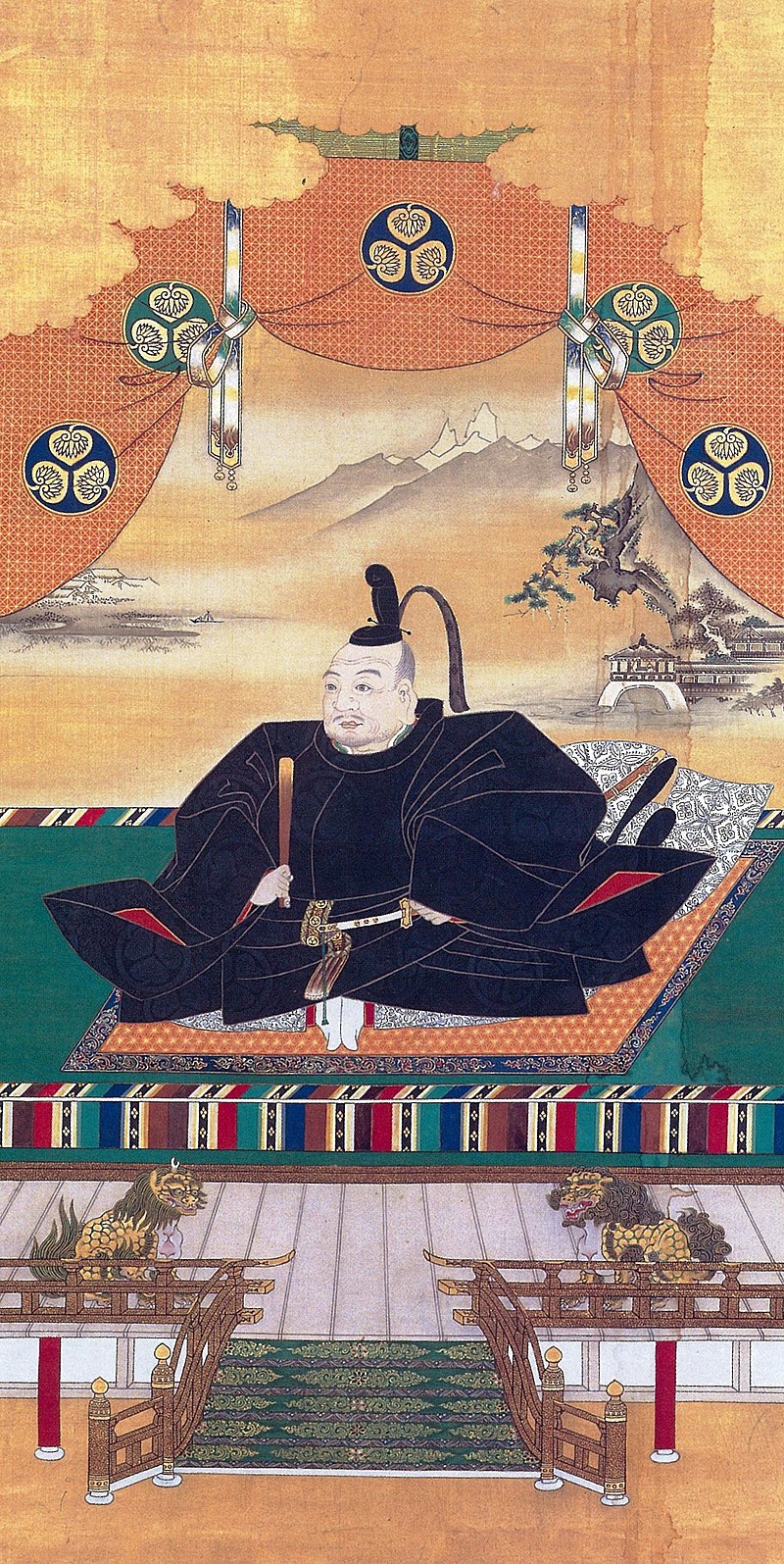
Above: Portrait of Tokugawa Ieyasu (1543 – 1616)
The modern city was formed on 1 April 1889, with the merger of the former cities of Hakata and Fukuoka.
Historically, Hakata was the port and merchant district, and was more associated with the area’s culture and remains the main commercial area today.
On the other hand, the Fukuoka area was home to many samurai, and its name has been used since Kuroda Nagamasa, the first daimyō of Chikuzen Province, named it after his birthplace in Okayama Prefecture and the “old Fukuoka” is the main shopping area, now called Tenjin.
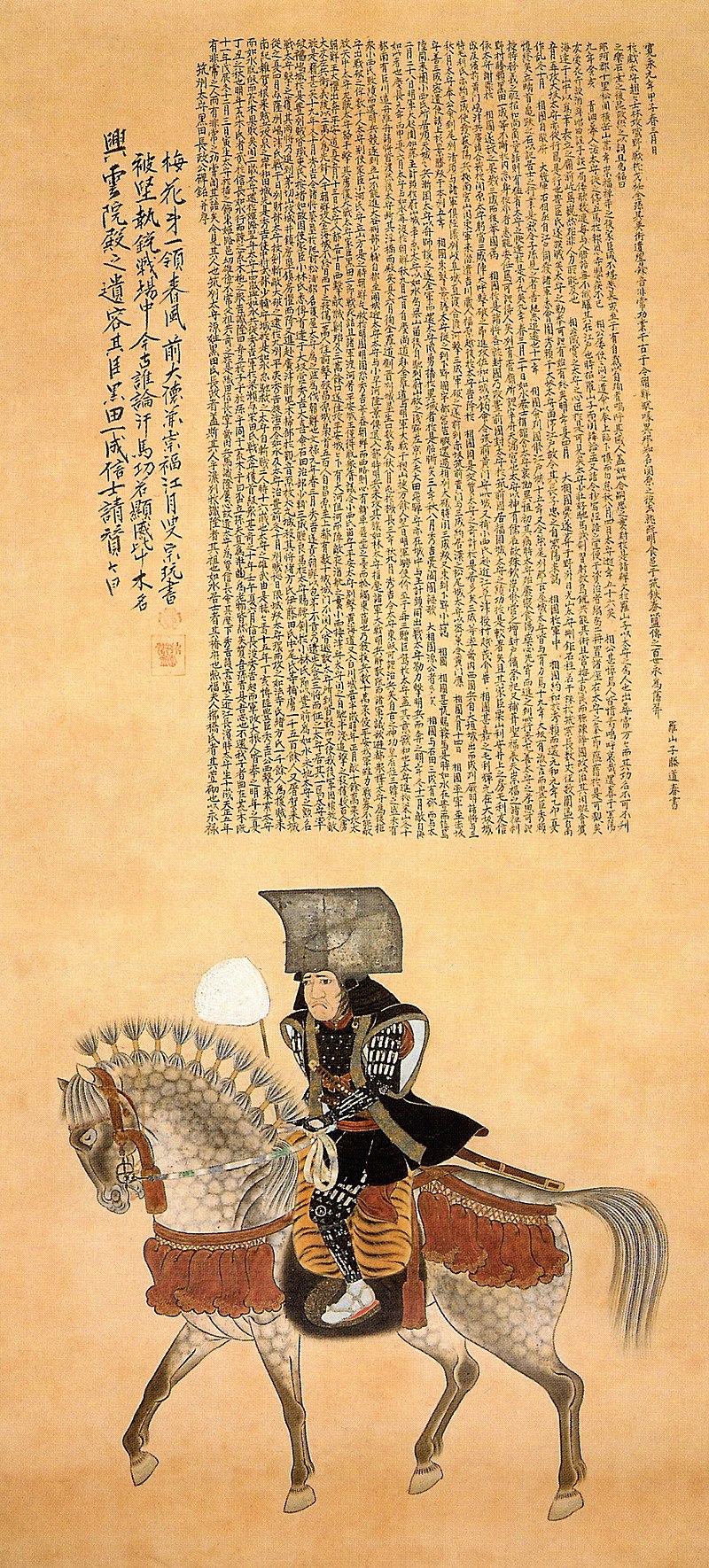
Above: Portrait of Kuroda Nagamasa (1568 – 1623)
When Hakata and Fukuoka decided to merge, a meeting was held to decide the name for the new city.
Hakata was initially chosen, but a group of samurai crashed the meeting and forced those present to choose Fukuoka as the name for the merged city.
However, Hakata is still used to refer to the Hakata area of the city and, most famously, to refer to the city’s train station, Hakata Station, and dialect, Hakata-ben.

Above: Hakata-ben dialect banners in Fukuoka
- 1903: Fukuoka Medical College, a campus associated with Kyoto Imperial University, is founded. (In 1911, the college is renamed Kyushu Imperial University and established as a separate entity.)
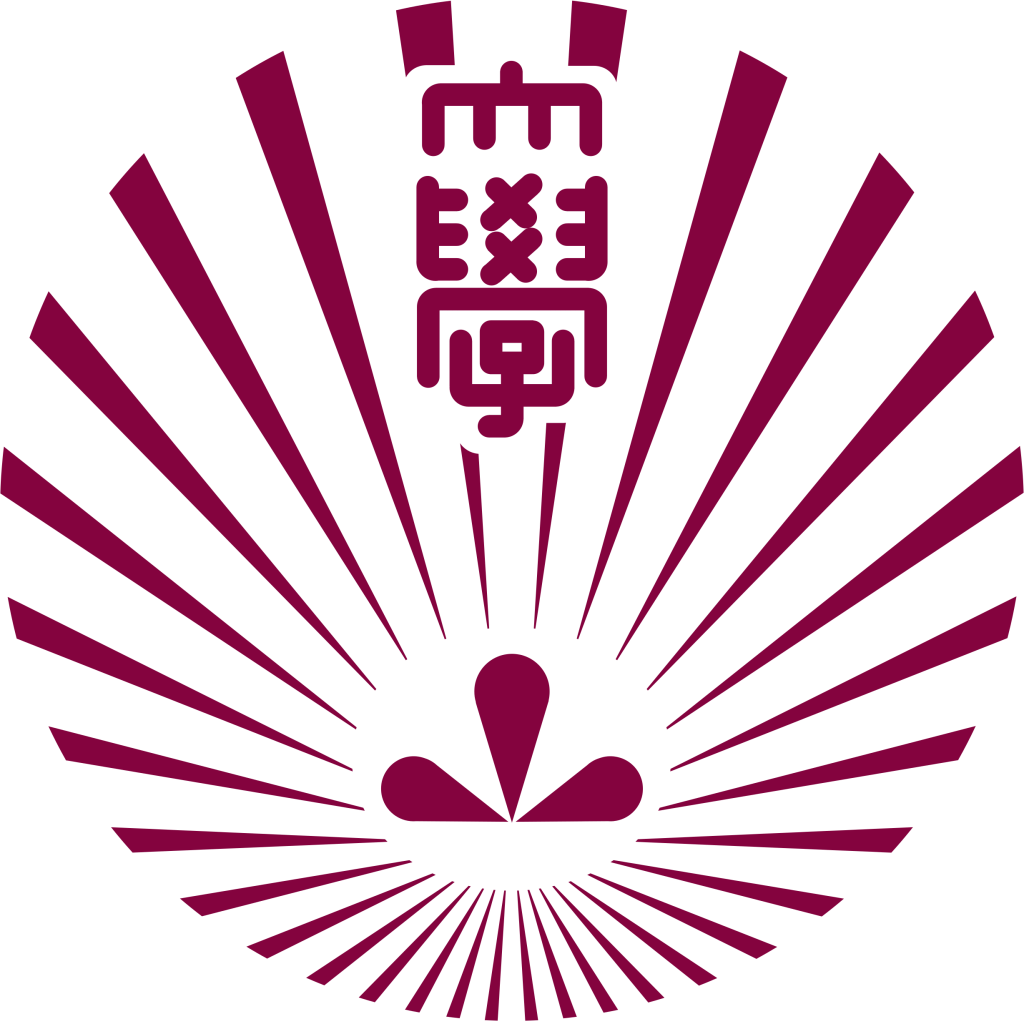
Above: Logo of Kyushu University
- 1910: Fukuoka streetcar service begins. (The service ran until 1979.)
![1920s Japan - Japanese Streetcar in Fukuoka City ] — A streetcar on Higashi Nakasu in Fukuoka City, Fukuoka Prefecture. The big sign on the right advertises Sakura Beer. Therefore the](https://c8.alamy.com/comp/WP5T0M/1920s-japan-japanese-streetcar-in-fukuoka-city-a-streetcar-on-higashi-nakasu-in-fukuoka-city-fukuoka-prefecture-the-big-sign-on-the-right-advertises-sakura-beer-therefore-the-cherry-blossom-mark-on-top-of-the-building-20th-century-vintage-postcard-WP5T0M.jpg)
- 1929: Flights commence along the Fukuoka – Osaka – Tokyo route.

Above: International terminal, Fukuoka Airport
- 1945: Fukuoka was firebombed on 19 June, with the attack destroying 21.5% of the city’s urban area.

- 1947: First Fukuoka Marathon
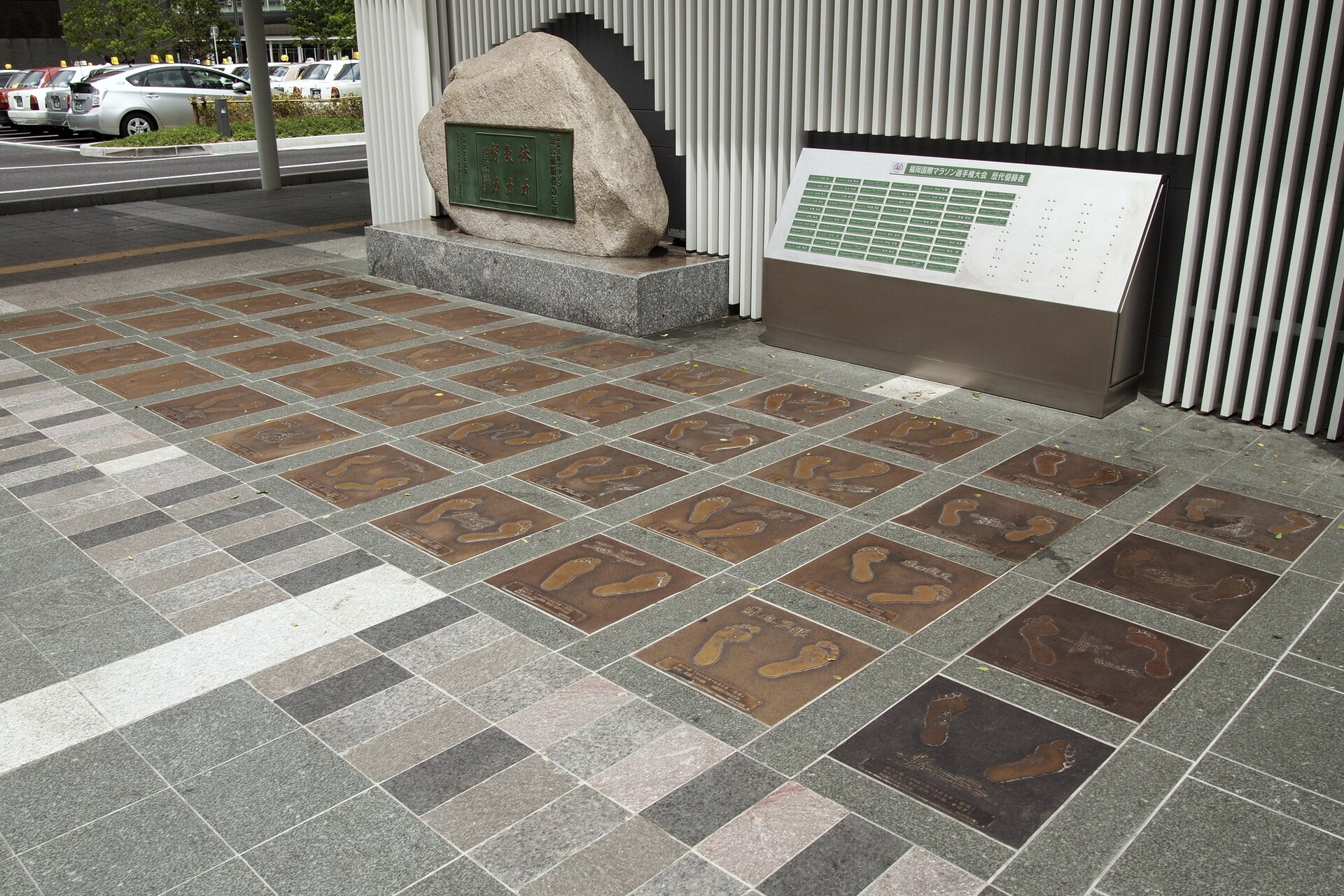
Above: The Fukuoka Marathon monument at Hakata Station with footprints of past winners
- 1951: Fukuoka airport opens.

Above: Inside the International Terminal, Fukuoka Airport
- 1953: Fukuoka Zoo opens.
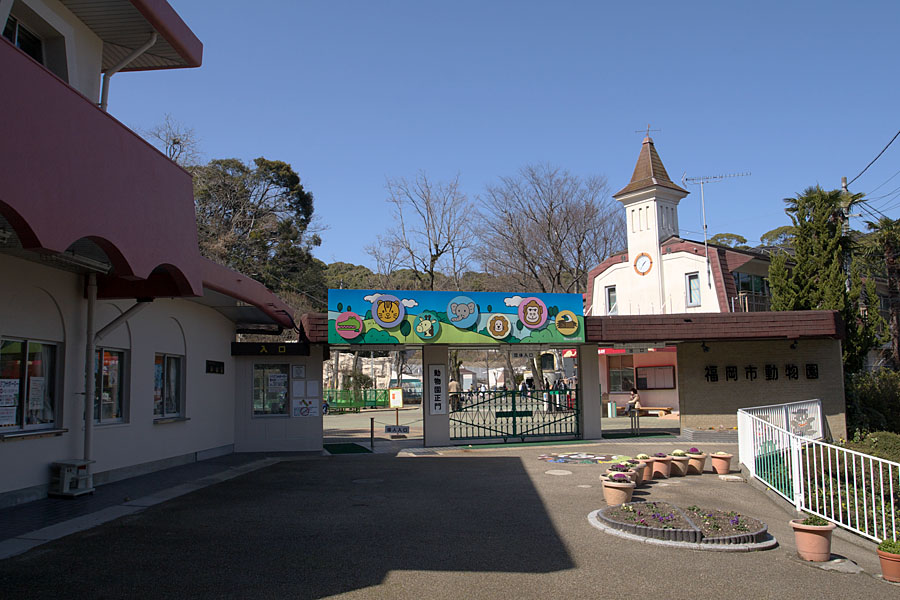
Above: Entrance to Fukuoka Zoo and Botanical Garden
- 1975: The city absorbed the town of Sawara.
- 1981: Subway commences service.

- 1988: Osaka’s pro baseball team, the Nankai Hawks, was moved to Fukuoka and renamed the Fukuoka Daiei Hawks (renamed the Fukuoka SoftBank Hawks in 2004).

- 1989: Asian-Pacific Exposition is held.
- 1997: The 30th annual meeting of the Asian Development Bank was held in Fukuoka.

- 2005: Fukuoka subway Nanakuma Line started operations.

- 2014: Selected as the National Strategic Zone for “global startups and job creation” by the Japanese government.
- 2020: City affected by Covid-19. As of October, there have been 99 deaths due to Covid in Fukuoka Prefecture.

(Covid-19 arrived in Japan on 1 January 2020.
As of 13 December 2020, there have been:
- 198,880 confirmed cases
- 165,333 recoveries
- 2,873 deaths)
Fukuoka is bordered on three sides by mountains, surrounds Hakata Bay and opens on the north to the Genkai Sea.

Fukuoka is not as seismically active as many other parts of Japan, but does experience occasional earthquakes.
The most powerful recent earthquake registered a lower 6 of maximum 7 of the Japanese intensity scale and hit at 10:53 am local time on 20 March 2005, killing one person and injuring more than 400.

Above: Earthquake damage to Fukuoka Building
Fukuoka is the economic center of the Kyushu region, with an economy largely focused on the service sector.
It is also the largest startup city in Japan and is the only economic zone for startups.
They have various services for startups like startup visa, tax reduction, and free business consultations.
Fukuoka has the highest business-opening rate in Japan.
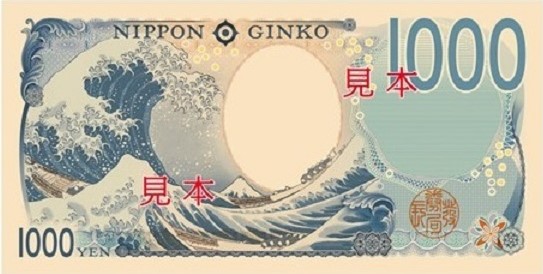
Large companies headquartered in the city include Iwataya (department store chain) and Kyushu Electric Power.

Above: Logo of Kyushu Electric Power
Fukuoka is also the home of many small firms playing a supportive role in the logistics, IT and high-tech manufacturing sectors.
Most of the region’s heavy manufacturing takes place in the nearby city of Kitakyushu.

Above: Images of Kitakyushu
Several regional broadcasters are based in the city, including Fukuoka Broadcasting Corportation (FBS), Kyushu Asahi Broadcasting (KBS), Love FM, RKB Mainichi Broadcasting and Television Nishinippon Corportation.

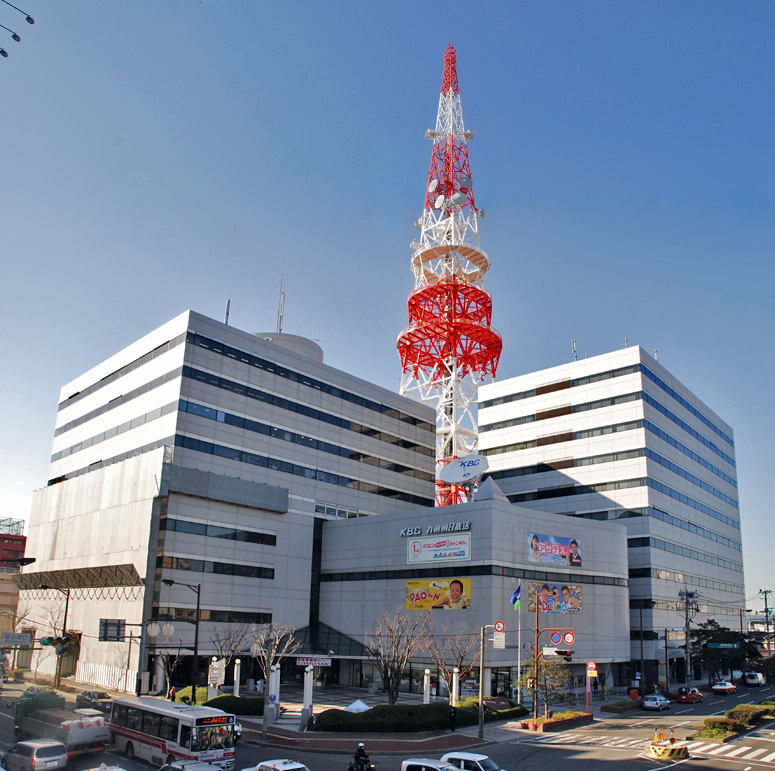



The port of Hakata and Fukuoka Airport also make the city a key regional transportation hub.
Fukuoka houses the headquarters of Kyushu Railway Company (JR Kyushu) and Nishi-Nippon Railroad.

Air Next, a subsidiary of All Nippon Airways (ANA), is headquartered in Hakata-ku.
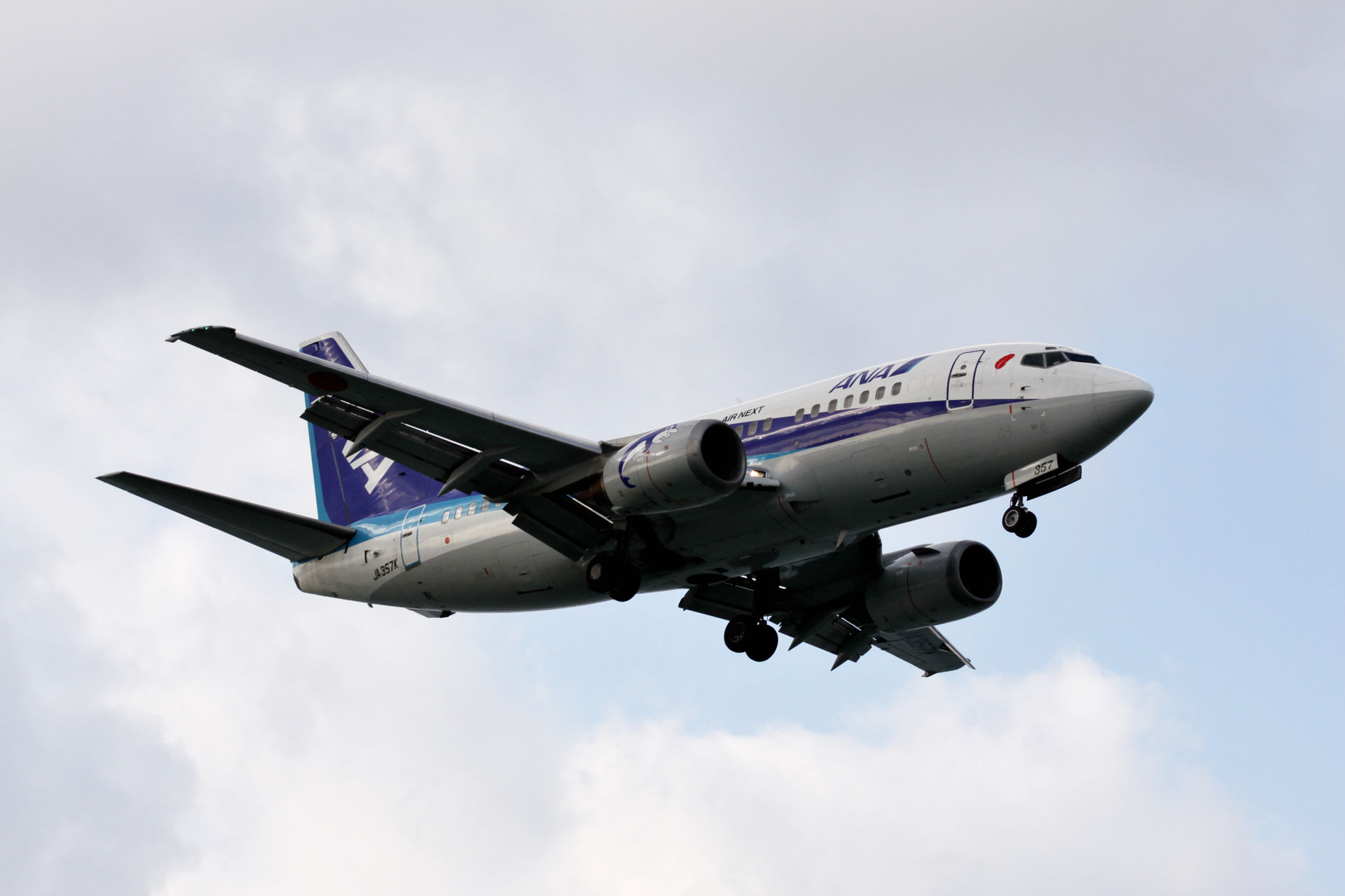
Fukuoka has its own stock exchange, founded in 1949.
It is one of six in Japan.

Fukuoka is one of the more affordable cities in Japan.
Compared to New York City, rents are 80% lower, restaurants are 50% cheaper, and groceries are 5% more expensive.
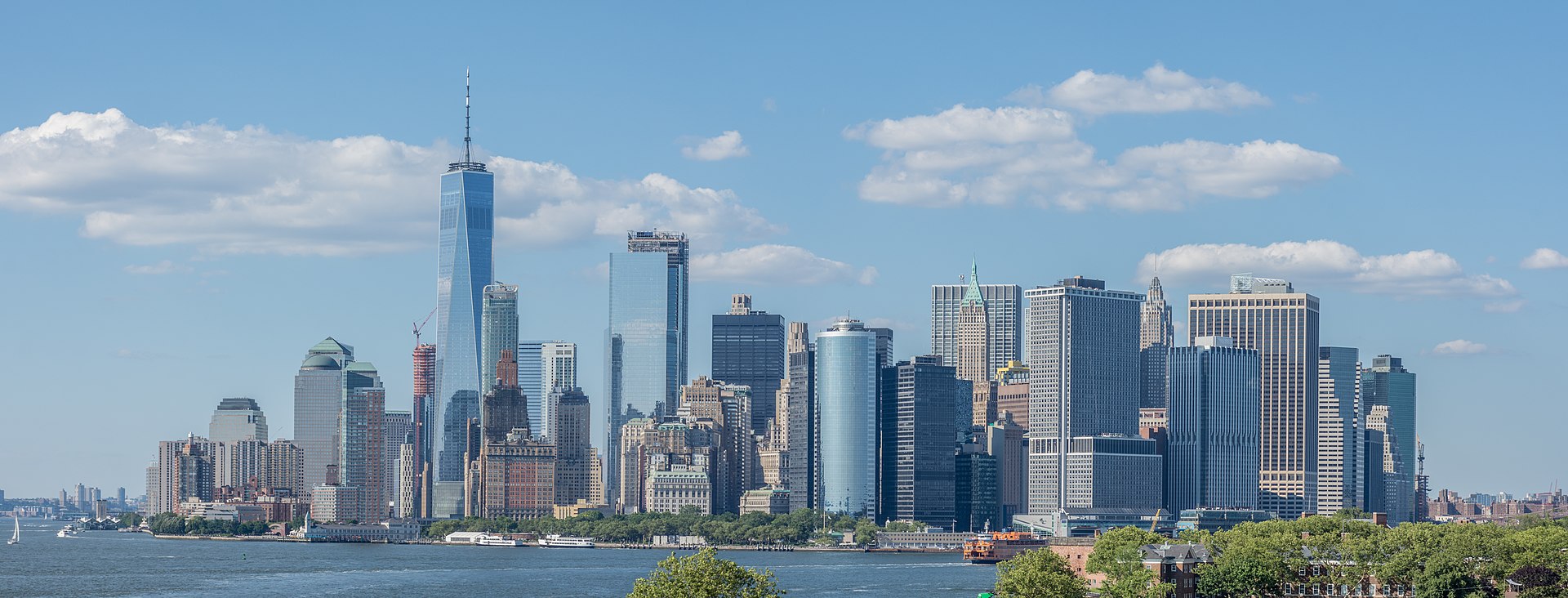
Above: Lower Manhattan, New York City
Fukuoka was selected as one of Newsweek‘s ten “Most Dynamic Cities” in its July 2006 issue.
It was chosen for its central Asian location, increasing tourism and trade, and a large increase in volume at its sea and airport.

Fukuoka has a diverse culture and a wide range of cultural attractions.
In its July/August 2008 issue, Monocle selected Fukuoka as number 17 of the “Top 25 liveable cities“.
It was chosen for excellent shopping, outstanding food, good transport links, good museums, “a feeling of openness in its sea air“, green spaces and because it is friendly, safe, clean and close to the rest of East Asia.

Fukuoka hosts more than two million foreign visitors annually, with the majority coming from neighboring South Korea, Taiwan and China.
From the early 2010s, Hakata became the beneficiary of significant growth in cruise ship tourism, particularly with visitors from China.
After expansion and redevelopment of the Hakata Port international passenger ship terminal, the number of cruise ship port calls in 2016 is expected to exceed 400.
Nearly ten thousand international students attend universities in or near the Fukuoka prefecture each year.
Nearly 200 international conferences are held each year in Fukuoka.

Momo “met” Eriko through a computer app (so modern an age that we live in!) and over the course of many months of mutual correspondence and communication, Eriko agreed to play Momo’s guide for a fortnight in Fukuoka.
But as Eriko, like far too many Japanese, must work, must overwork, Momo, Eriko and her husband would see each other in the evenings and on the weekends only.
This gave Momo much time on his own to explore Fukuoka and the island upon which it sits, Kyushu.

From his Airbnb lodgings, Momo would discover the joys of being a solitary walker mornings and afternoons.

Momo discovered, like many others before and since have, that this city, Japan’s 6th largest city, is one of the most likeable places in Japan.
Indeed, despite the fact that Fukuoka (“happy hills“) is not exactly a household name abroad, Fukuoka, as suggested above, regularly pops up on global best-places-to-live lists.
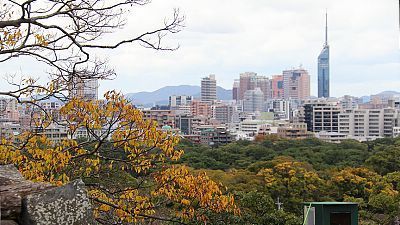
While Fukuoka boasts few actual sights, there is a certain Kyushu-style joie de vivre here, a laidback bohemian feel, best exemplied at the umpteen rustic curbside yatai (roadside food stalls), where the local yokels slurp happily away on their ramen (noodles) while knocking back beer, saké, or whatever floats one’s boat.
![2019 Edition/Multilingual Menus Available] 5 Famous Yatai Stalls in Fukuoka Where Lining Up Is Inevitable](https://wow-j.com/images/ext/allguides/02298/9ae0d3bf8595fbe680b667a3ef09ca95-1.jpg)

Until recently, the city was an industrial nonentity, much like the Ruhrgebiet of Germany or Canada’s Mississauga.

Above: Zollverein Coal Mine Industrial Complex in Essen (Germany), UNESCO World Heritage Site since 2001

Above: Mississauga, Ontario, Canada
(“I would like to make an appointment with the Doctor.“
“I’m sorry. The Doctor is dead.“
“Dead?“
“Well, not actually dead. He moved to Mississauga.“)
Until recently, Fukuoka was notable only for its transport connections to South Korea and the rest of Japan.
This city’s renaissance has been remarkable.
Visit today and you will find a squeaky-clean (almost Canadian in its cleanliness) metropolis that makes for a great introduction to Kyushu, or indeed Japan as a whole, so, as such, it deserves a day, two days or even two weeks of any traveller’s time and attention.

Highlights of Fukuoka include a couple of excellent museums and ranks of eye-catching modern architecture, notably the shopping and leisure complex of Canal City.
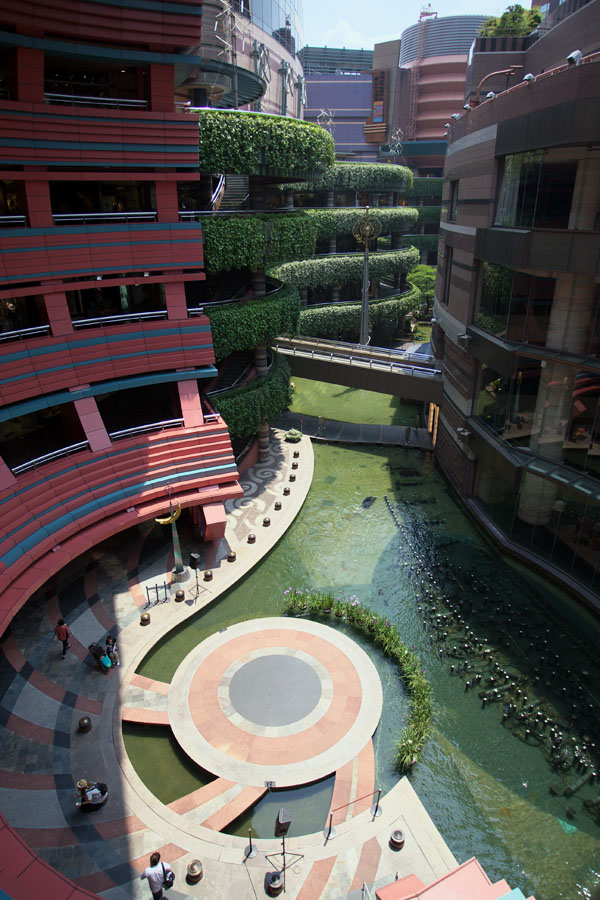
Above: Canal City
As well any self-respecting Japanese city of this size, Fukuoka maintains a lively entertainment district, crammed onto the tiny river island of Nakasu, though it is safer on the wallet to head for the less glitzy bars and restaurants of Tenjin, the city’s main downtown area.

Above: Tenjin
Further west is Ohori-koen – where you will find the ruins of Fukuoka Castle, as well as an art museum with an important collection of 20th century works – and Momochi, home to the iconic Fukuoka Tower.

Above: Fukuoka Castle

Above: Fukuoka Tower
Sky Dream Fukuoka, in Fukuoka’s western ward, was one of the world’s largest Ferris wheels at a height of 120 meters.
It was closed in September 2009 and was partially rebuilt in Taichung, Taiwan.

Above: Sky Dream Fukuoka
(Compare this to the prospect of London one day losing its London Eye.)

Above: London Eye
The surrounding shopping center, Marinoa City Fukuoka, still attracts millions of visitors each year.
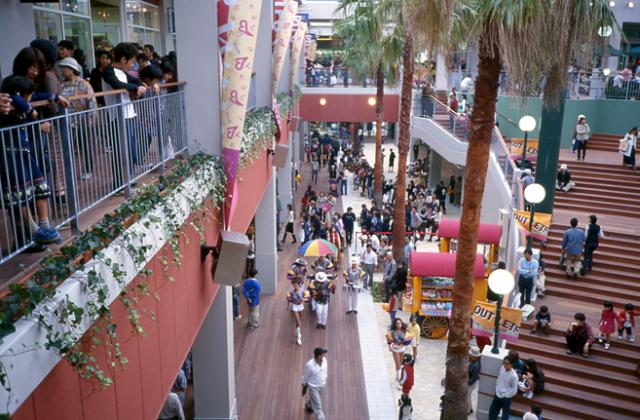
Other shopping centers that attract tourists include Canal City, JR Hakata City, and Hakata Riverain.
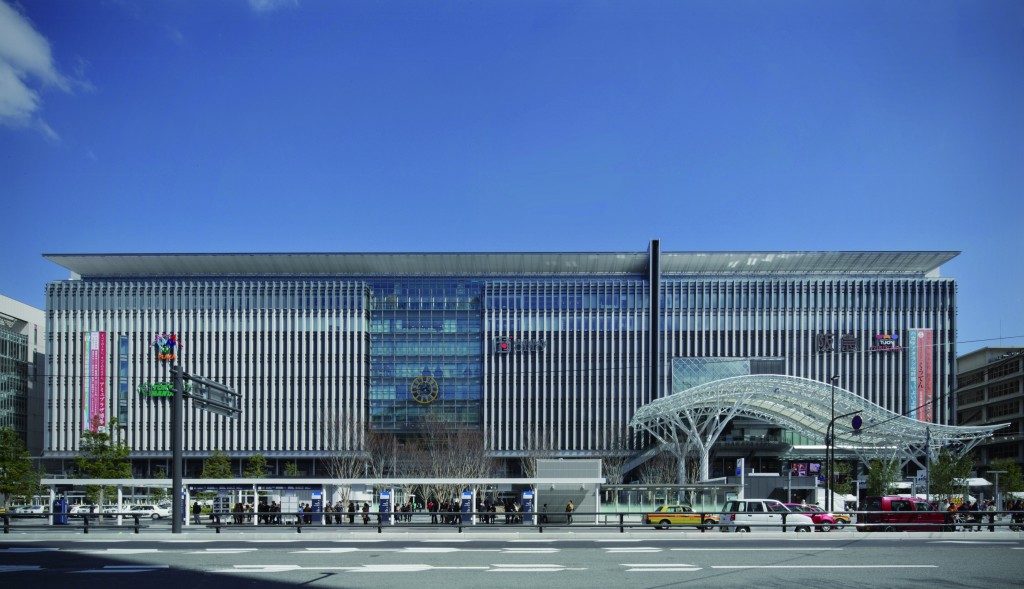
Above: JR Hakata City
Fukuoka Castle, located adjacent to Ohori Park in Maizuru Park, features the remaining stone walls and ramparts left after a devastating fire during the upheaval of the Meiji Restoration (1868 – 1914).
It has now been preserved along with some reconstructed prefabricate concrete towers constructed during the 1950s and 1960s, when there was a trend across Japan to rebuild damaged castles as tourist attractions.

Ohori Park is also the location of one of Fukuoka City’s major art galleries.

Above: Ohori Park
There are many temples with long histories including Tocho-ji, Hakozaki Shrine, Kashii Shrine and Joten-ji.

Above: Main Hall, Tocho-ji

Above: Hakokazi-gu

Above: Kashii-gu

Above: Main Hall, Joten-ji
The Marine Park Uminonakamichi is located on a narrow cape on the northern side of the Bay of Hakata.
The park has an amusement park, petting zoo, gardens, beaches, a hotel, and a large marine aquarium which opened in 1989.
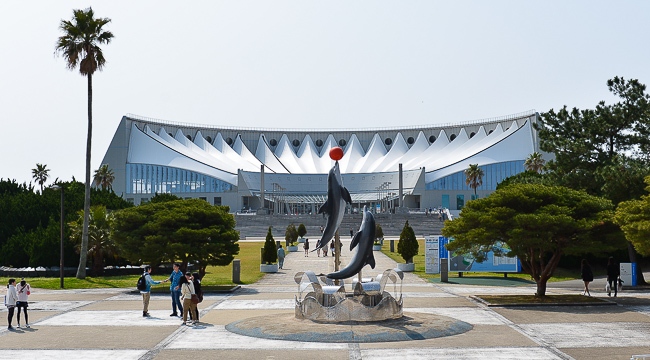
For tourists from other parts of Japan, local foods such as mentaiko (a cod dish), Hakata ramen (local noodles) and motsunabe (a type of beef/pork stew) are associated with Fukuoka.

Above: Mentaiko
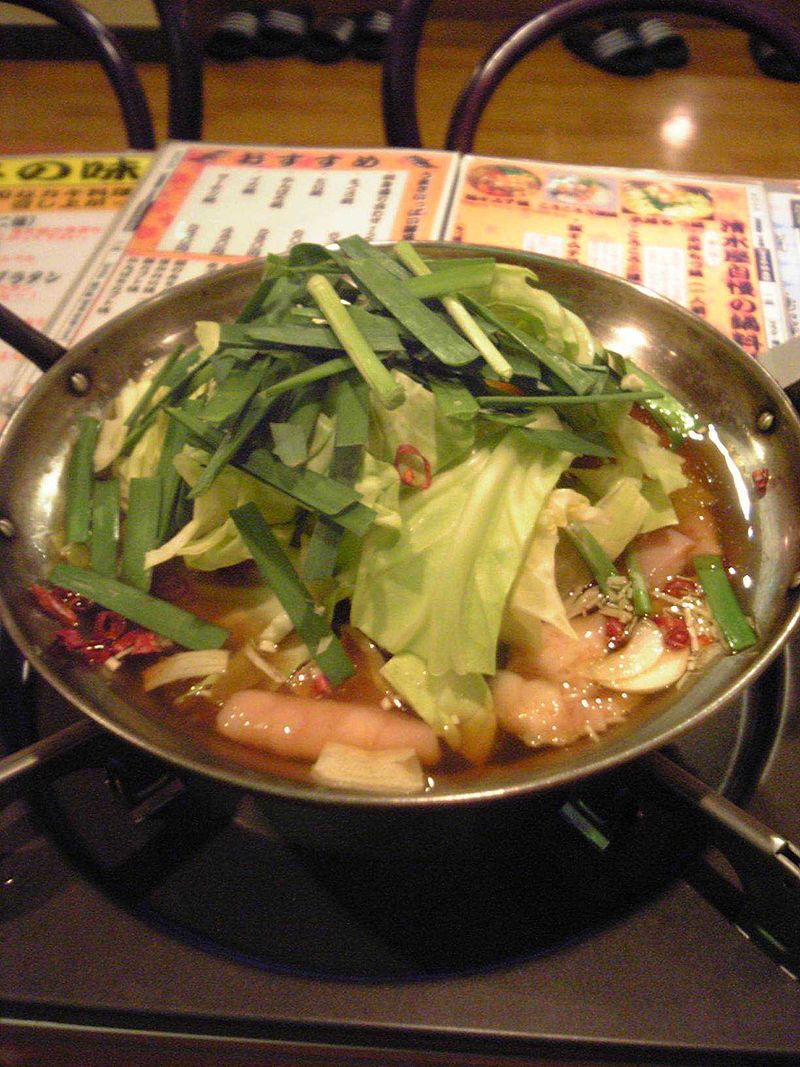
Above: Motsunabe
Yatai (street stalls) serving ramen can be found in Tenjin and Nakasu most evenings.

Fukuoka Tower is near the beach in Seaside Momochi, a development built for the 1989 Asia-Pacific Exhibition.
The older symbol of the city, Hakata Port Tower is next to the international ferry terminal and is free to enter.

Above: Hakata Port Tower
Itoshima, to the west of Fukuoka city, has recently become a very popular tourist destination.

Above: Futamigaura Beach, Itoshima
There are many beaches along the coast, notably Futamigaura Beach, where there is a famous Shinto shrine in the ocean, and Keya Beach, which hosts the annual Sunset Live festival every September.

Above: Keya Beach
Inland, there is the Shingon Buddhist temple called Raizan Sennyoji, where there are many Buddhist statues and stunning autumn foliage.

The Buddhist Nanzoin temple is located in Sasaguri, just east of Fukuoka.

It is claimed to be the largest statue of a reclining Buddha in the world.

There is a newly opened Kyushu National Museum in nearby Dazaifu.
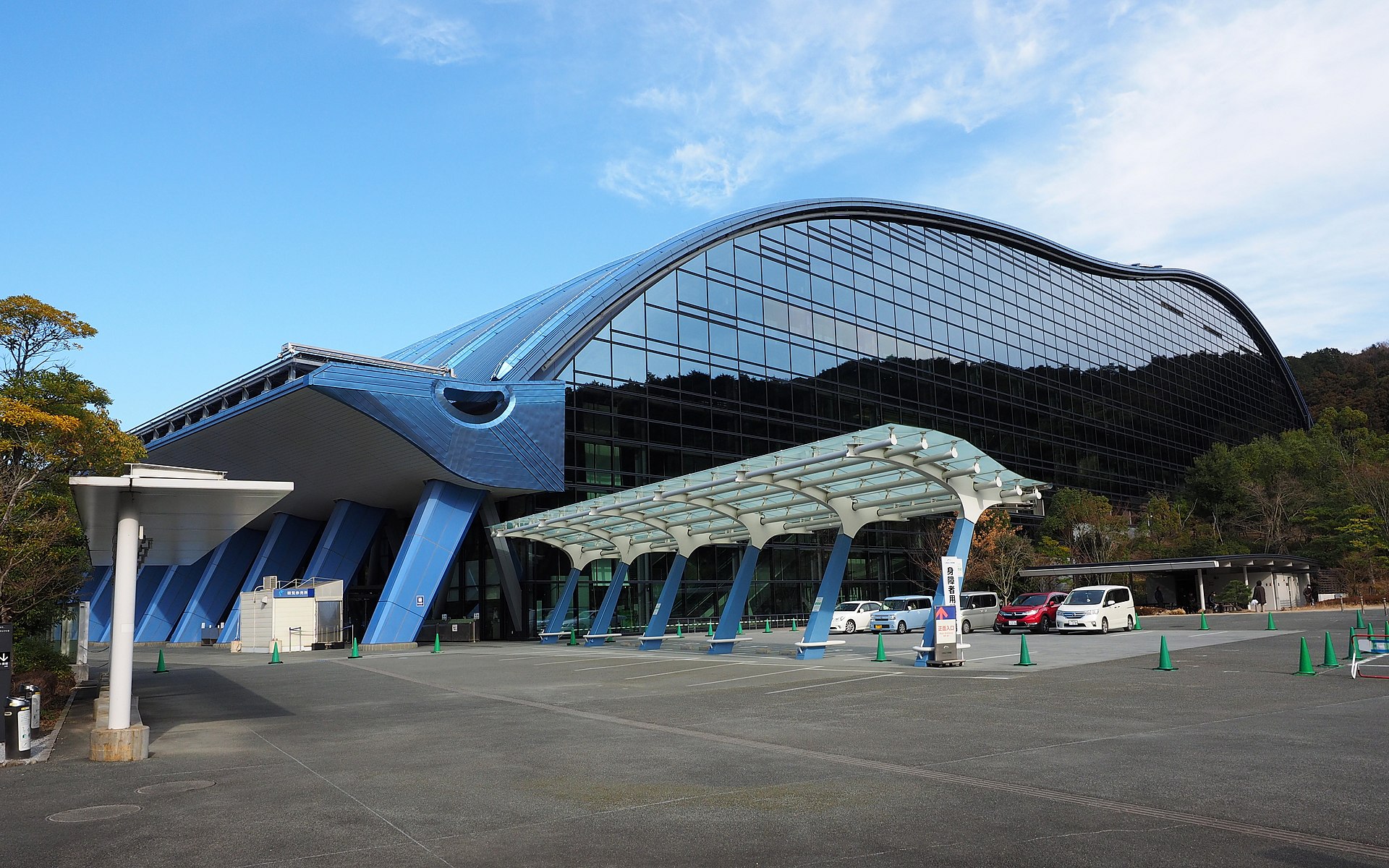
Above: Kyushu National Museum
Worth seeing while you are here:
- Fukuoka Art Museum – In Ohori Park, the Museum contains a wide selection of contemporary and other art from around the world, including works by Mark Rathko, Roy Lichetenstein and Salvador Dali.

- Fukuoka Asian Art Museum contains art from various countries of Asia.
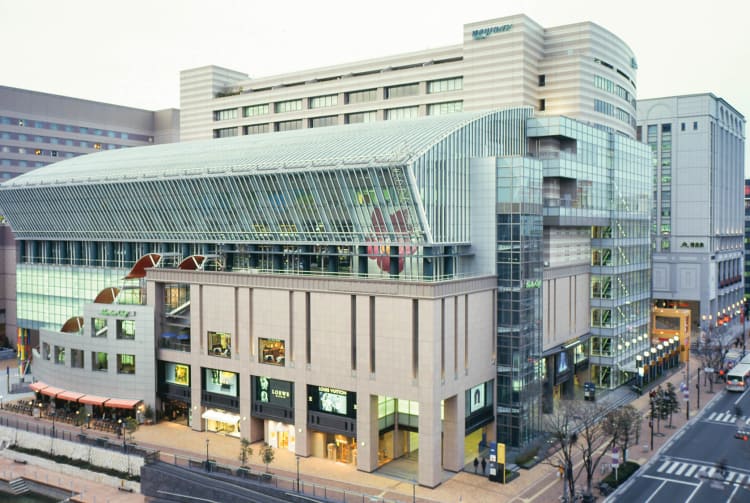
- Fukuoka City Museum displays a broad range of items from the region’s history, including a spectacular gold seal.
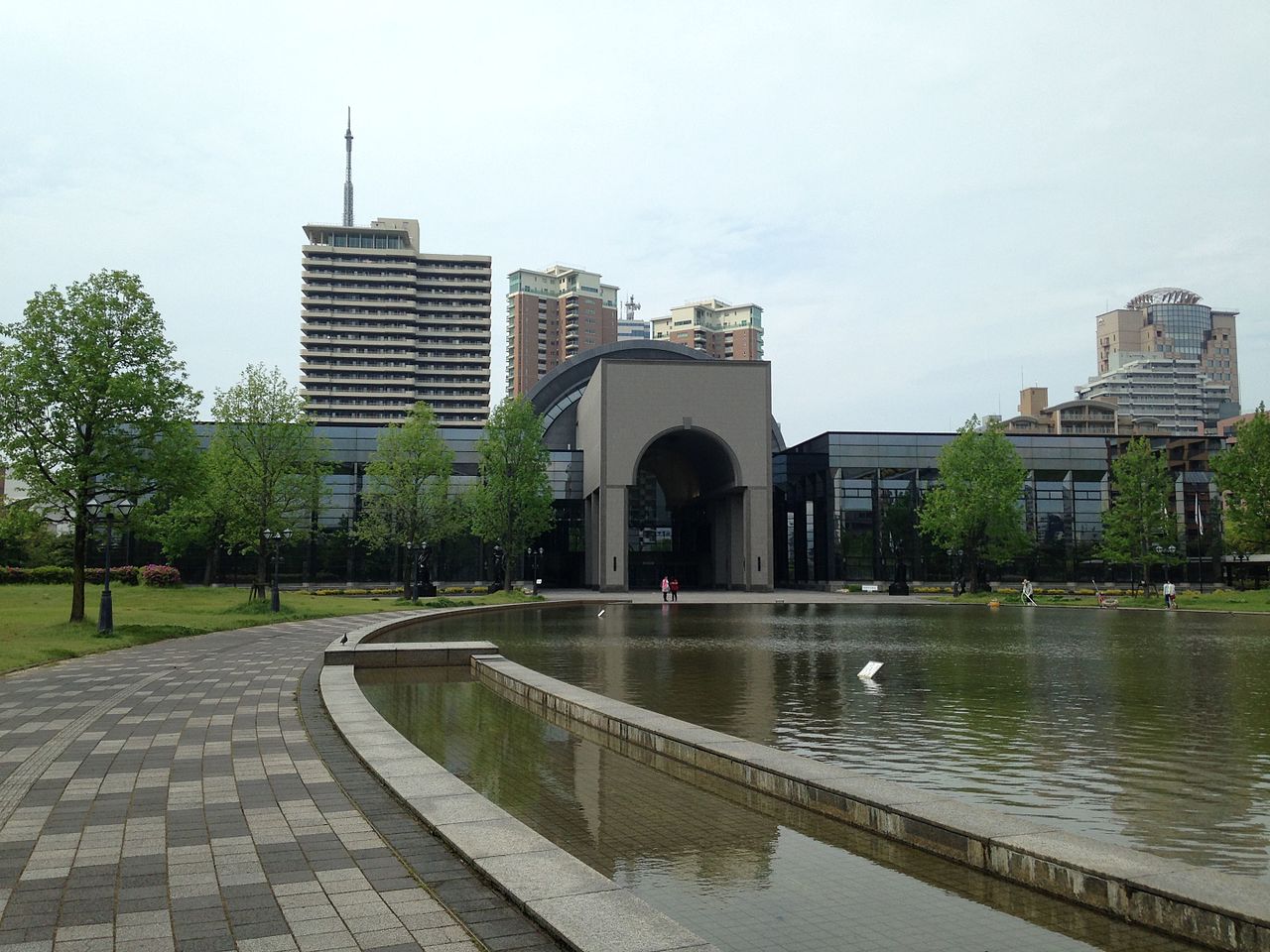
- Fukuoka Oriental Ceramics Museum

- Fukuoka Prefectural Museum of Art
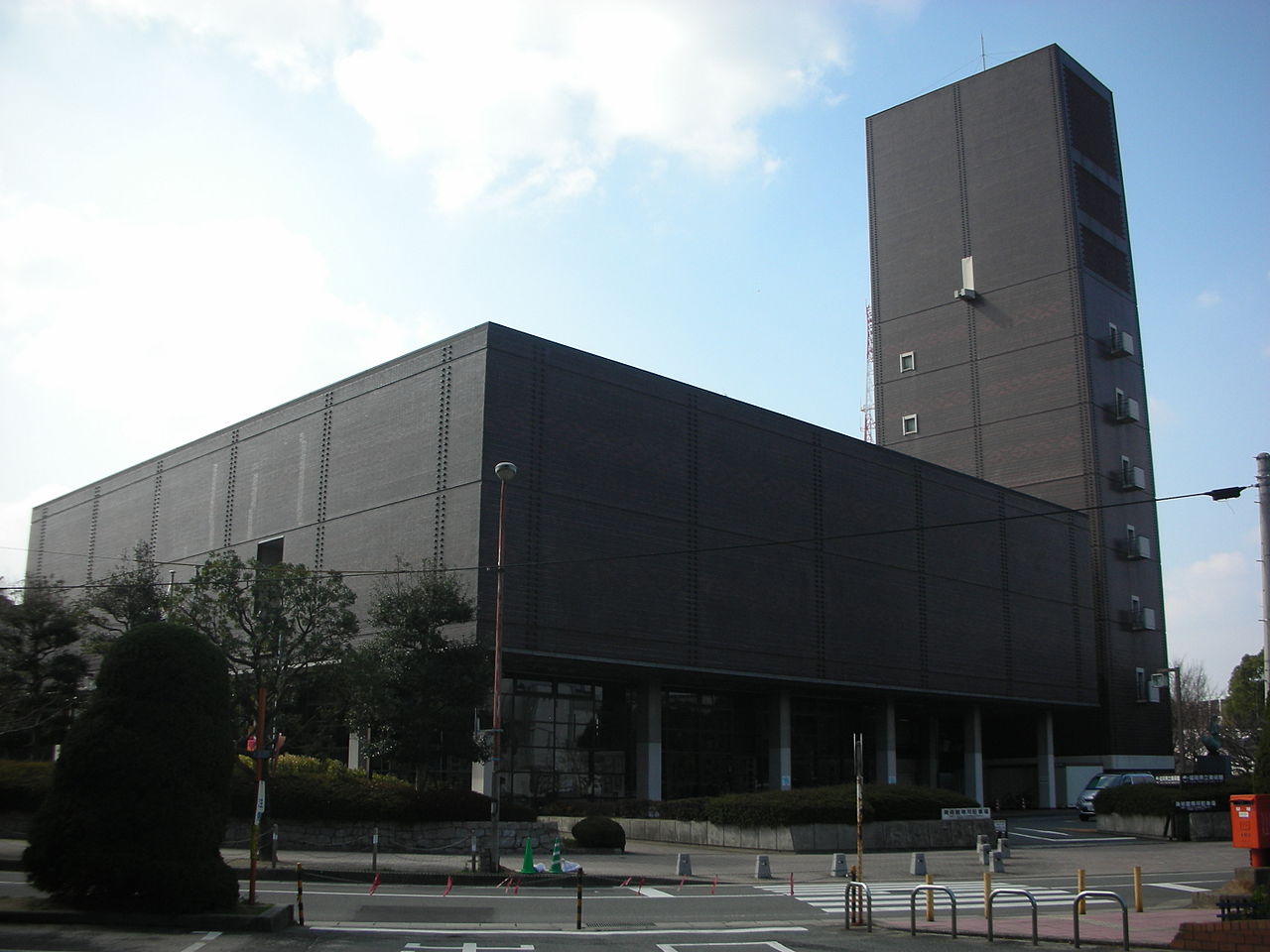
- Genko Historical Museum (元寇史料館, Museum of the Mongol Invasion) – In Higashi Koen (East Park), the Museum displays Japanese and Mongolian arms and armor from the 13th century as well as paintings on historical subjects. Open on weekends.

- Hakata Machiya Folk Museum is dedicated to displaying the traditional ways of life, speech, and culture of the Fukuoka region.

The Fukuoka Asian Culture Prize was established to honor the outstanding work of individuals or organizations in Asia.

Fukuoka is home to many festivals (matsuri) that are held throughout the year.
Of these, the most famous are Hakata Dontaku and Hakata Gion Yamakasa.
Sadly, Momo missed both.
Yamakasa (山笠), held for two weeks each July, is Fukuoka’s oldest festival with a history of over 700 years.
The festival dates back to 1241 when a priest called Shioichu Kokushi saved Hakata from a terrible plague by being carried around the city on a movable shrine and throwing water.
Teams of men (no women, except small girls, are allowed), representing different districts in the city, commemorate the priest’s route by racing against the clock around a set course carrying on their shoulders floats weighing several thousand pounds.

Participants all wear shimekomi (called fundoshi in other parts of Japan), which are traditional loincloths that cover the genitalia but leave one’s posterior almost completely exposed.
(Cheeky!)

Each day of the two-week festival is marked by special events and practice runs, culminating in the official race that takes place the last morning before dawn.
Tens of thousands line the streets to cheer on the teams.
During the festival, men can be seen walking around many parts of Fukuoka in long happi coats bearing the distinctive mark of their team affiliation and traditional geta sandals.
The costumes are worn with pride and are considered appropriate wear for even formal occasions, such as weddings and cocktail parties, during the festival.
(It appears to the casual eye as if an entire generation of young men spent the night in a traditional Japanese inn and decided to keep and display the inn’s traditional guest garments.)

Hakata Dontaku (博多どんたく) is held in Fukuoka City on 3 and 4 May.
Boasting over 800 years of history, Dontaku is attended by more than two million people, making it the festival with the highest attendance during Japan’s Golden Week (a week from 29 April to early May containing a number of Japanese holidays).
During the festival, stages are erected throughout downtown for traditional performances and a parade of floats is held.
The full name is Hakata Dontaku Minato Matsuri.
The festival was stopped for seven years during the Meiji era. Since it was restarted in the 12th year (1880) of the Meiji era it has been known as Hakata Dontaku.

Notable musical names in J-pop, including Ayumi Hamasaki (allegedly Japan’s richest woman), singer-songwriter Ringo Shiina, hugely popular singer-songwriter duo Chage & Aska, singer-songwriter Eri Nobuchika, Misia, Masamune Kusano and Yui, come from Fukuoka.

Above: Ayumi Hamasaki

Above: Ringo Shiina

Above: Chage & Aska
:format(jpeg):mode_rgb():quality(90)/discogs-images/A-363041-1383823349-8691.png.jpg)
Above: Eri Nobuchika

Above: Misia

Above: Masamune Kusano

Above: Yui
During the 1970s, local musicians prided themselves on their origins and dubbed their sound, Mentai Rock (from the aforementioned mentaiko).
Dominican songwriter and singer Juan Luis Guerra pays homage to the city in his bachata song Bachata en Fukuoka (2010).
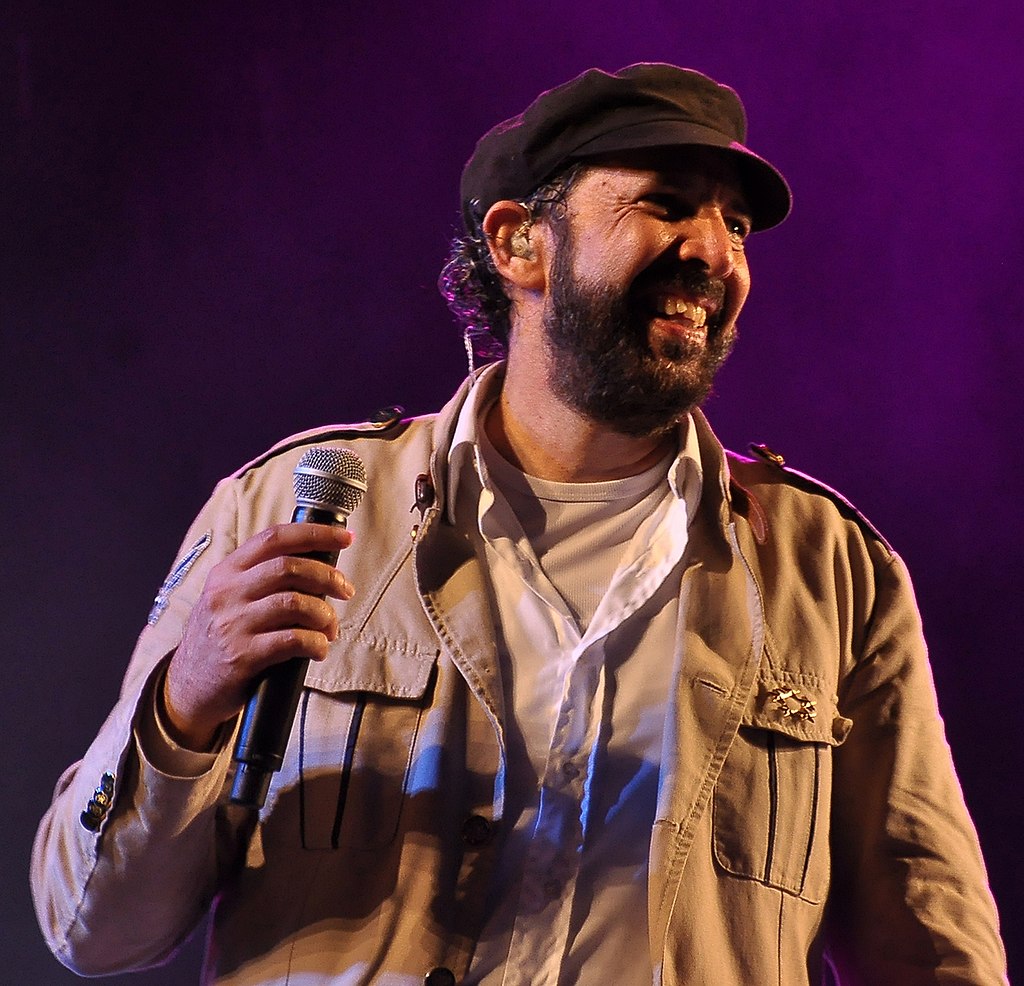
Above: Juan Luis Guerra
HKT48 (another popular J-Pop group) have their own theatre at Nishitetsu Hall.

Fukuoka is the home of the Fukuoka SoftBank Hawks, one of Japan’s top professional baseeball teams.
Threatened with bankruptcy and forced by its creditors to restructure, former owner Daiei sold the Hawks to Softbank Capital (an American firm) in 2004.
Fukuoka is home to a professional football (soccer) team, Avispa Fukuoka.

Annual sporting events include:
- The All Japan Judo Category Championships held in early April.

- The November tournament of professional sumo held at the Fukuoka Kokusai Center
- The Fukuoka International Open Marathon Championships, with start/finish at Heiwadai Athletic Stadium, held on the 1st Sunday of December.

Above: Ethiopia’s Tsegaye Kebede is the current course record holder.
Being a large metropolis, Fukuoka has produced its fair share of notable people.
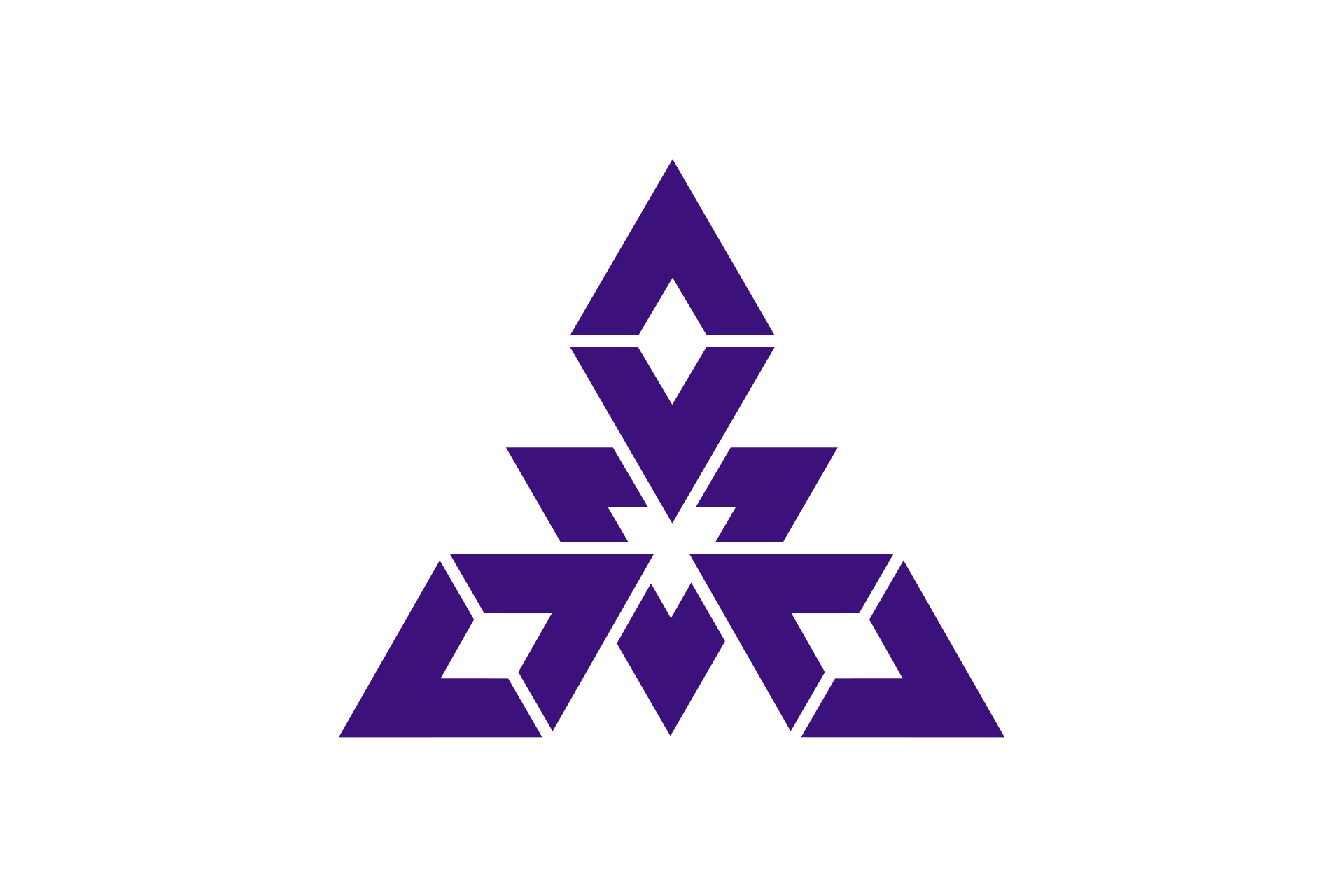
Above: Flag of Fukuoka
Among these are two novelists, 14 singers, eight actors (including actress Victoria Principal of the TV drama Dallas), a philosopher, a model, a famous doctor, a film director, two rock bands, a manga artist, three wrestlers, a famous DJ, two judo athletes, a ballet dancer (Birmingham Ballet), two basketball players and a legendary business magnate.

Above: Victoria Principal
Momo is in his late 20s, while I am old enough to be his father.
(Thankfully for him, it is clear that he is too handsome to be my offspring!)

Above: Peach Pal
Our age difference means that what one appeals to one might not appeal to the other.
Momo is interested in music and fashion, which abounds in Fukuoka.
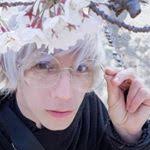
Fukuoka had already been on my “radar” before I met Momo.
Had I decided to renew my contract as an ESL teacher in South Korea (1999 – 2000), the school would have flown me to Fukuoka to arrange my work visa at the South Korean consulate there.
It is still a common practice for ESL teachers to fly to South Korea, find a school interested in engaging their services and then the school sends them to Fukuoka.
Had I not already committed myself to a relationship to the woman who became my wife, this visit to Fukuoka might have happened.
Had I gone to Fukuoka I think I would have done much of the walking Momo did, but I think, besides the museums, I would have been drawn to the city’s famous novelists and philosopher.

Above: Flag of South Korea
Kaibara Ekken (1630 – 1714) or Ekiken, also known as Atsunobu (篤信) was a Japanese Neo-Confucianist philosopher and botanist.
Kaibara was born into a family of advisors to the daimyo (lord) of Fukuoka Domain in Chikuzen Province (modern-day Fukuoka Prefecture).
He accompanied his father to Edo in 1648, and was sent in 1649 to Nagasaki to study Western science.
At his father’s urging, he continued his studies in Nagasaki as a ronin (mercenary knight) from 1650 through 1656.
He then re-entered service to Kuroda, which led to his continuing studies in Kyoto.
After his father’s death in 1665, he returned to Fukuoka.

Kaibara’s two most significant contributions to Japanese culture were the study of nature based on a blend of Western natural science and Neo-Confucianism, and the translation of the complex writings of Neo-Confucianism into vernacular Japanese.
His synthesis of Confucian ideas and Western science influence the formation of Shinto, especially State Shinto and reflect similar concerns to the Kokugaku movement (a refocus of Japanese scholarship away from the then-dominant study of Chinese, Confucian and Buddhist texts in favor of research into the early Japanese classics.
Kaibara’s science was confined to botany and Materia medica and focused on “natural law“.
Kaibara became as famous in Japan as people such as Charles Darwin when it came to science.
He advanced the study of botany in Japan when he wrote Yamato honzō (Medicinal herbs of Japan), a seminal study of Japanese plants.

The 19th-century German Japanologist Philipp Franz von Siebold called Kaibara “the Aristotle of Japan“.
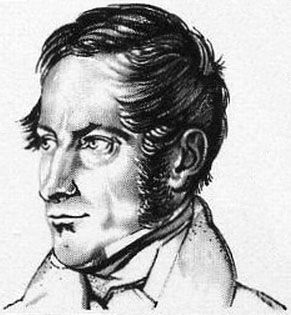
Above: Philipp Franz von Siebold (1796 – 1866)
Kaibara was known for his manuals of behavior, such as changing his Confucian ethical system based on the teachings of Zhu Xi (1130 – 1200) (also known as Chu Hsi) into an easy “self-help” manuals.
As an educator and philosopher, it appears that Kaibara’s main goal in life was to further the process of weaving Neo-Confucianism into Japanese culture.
In this context, he is best known for such books as Precepts for Children and Greater Learning for Women (Onna daigaku), but modern scholarship argues that it was actually prepared by other hands.
Although the genesis of the work remains unchallenged, the oldest extant copy (1733) ends with the lines “as related by our teacher Ekiken Kaibara” and the publisher’s colophon states that the text was written from lectures of our teacher Kaibara.
As for the novelists:
Yumeno Kyūsaku (1889 – 1936) was the pen name / nom de plume of Sugiyama Yasumichi, Japanese author, Zen priest, post office director and sub-lieutenant.
His pen name roughly means “a person who always dreams“.
He wrote detective novels and is known for his avant-gardism and his surrealistic, wildly imaginative and fantastic, even bizarre narratives.
His eldest son, Sugiyama Tatsumaru, was known as “the Green Father of India“.
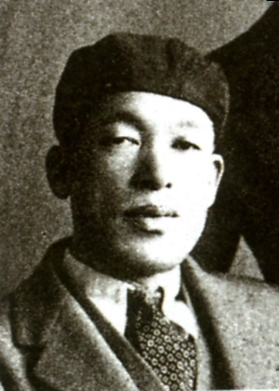
Yumeno was born in Fukuoka as Sugiyama Naoki.
His father, Sugiyama Shigemaru, was a major figure in the pre-war ultranationalist organization, the Genyosha.

Above: Gen’yosha logo
(The declared aims of the Gen’yōsha were “to honor the Imperial Family, respect the Empire and to guard the rights of the people“.
However, its true agenda was to agitate for Japanese military expansion and conquest of the Asian continent.
The true agenda was reflected in its new name of Gen’yōsha, taken after the Genkainada Strait, one name for the passage of water which separates Japan from Korea.
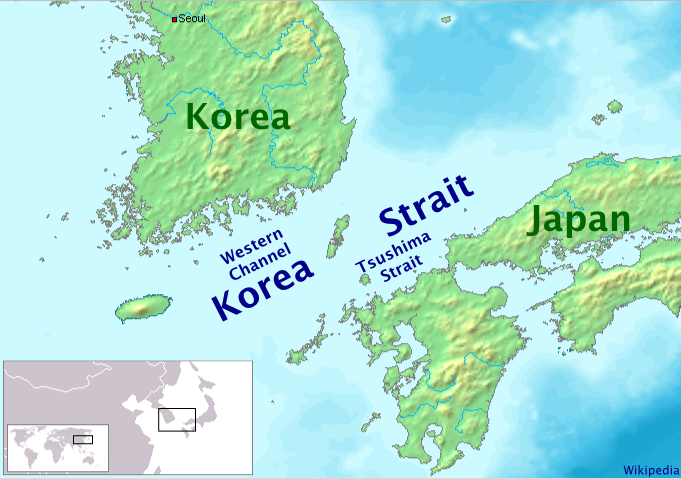
The tactics which the Gen’yōsha was prepared to use to achieve its goals were also far from peaceful.
It began as a terrorist organization, and although it continued to recruit disaffected ex-samurai (knights), it also attracted figures involved in organized crime to assist in its campaigns of violence and assassination against foreigners and liberal politicians.)

Above: A Gen’yosha memorial
(I will never fully understand why liberals are so hated and feared when true liberals are all about love and unity.)

After graduating from Shuyukan High School, Yumeno attended the Literature Department at Keio University, but dropped out on orders from his father, and returned home to take care of the family farm.

In 1926 he decided to become a Buddhist priest, but after a couple of years in the monastery, he returned home again as Sugiyama Yasumichi.
By this time, he had developed a strong interest in the traditional Japanese drama form of Noh, with its genre of ghost stories and supernatural events.
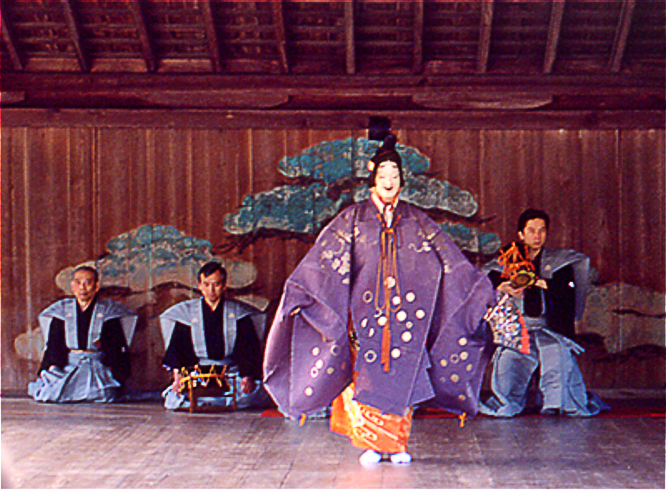
Above: A Noh performance
He found employment as a freelance reporter for the Kyushu Nippō newspaper, while writing works of fiction on the side.
Kyūsaku’s first success was a nursery tale Shiraga Kozō (White Hair Boy, 1922), which was largely ignored by the public.

It was not until his first novella, Ayakashi no Tsuzumi (The Spirit Drum, 1924) in the literary magazine Shin-Seinen that his name became known.

His subsequent works include Binzume jigoku (Hell in the Bottles, 1928), Kori no hate (End of the Ice, 1933) and his most significant novel Dogra Magra (Stray Dogs, 1935), which is considered a precursor of modern Japanese science fiction and was adapted for a 1988 movie.
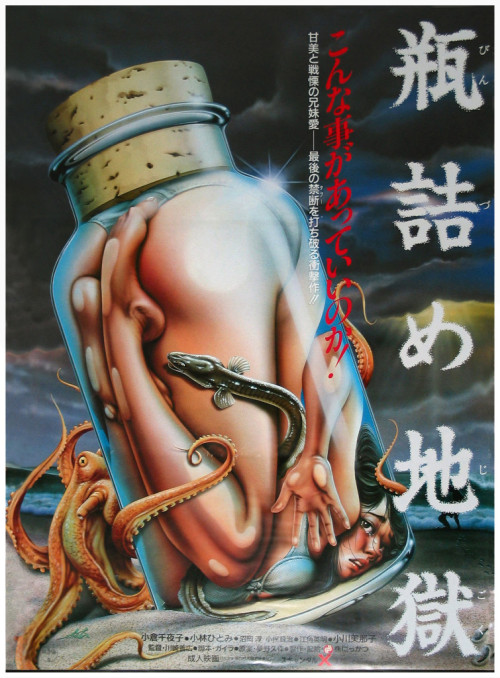
Above: Hell in a Bottle

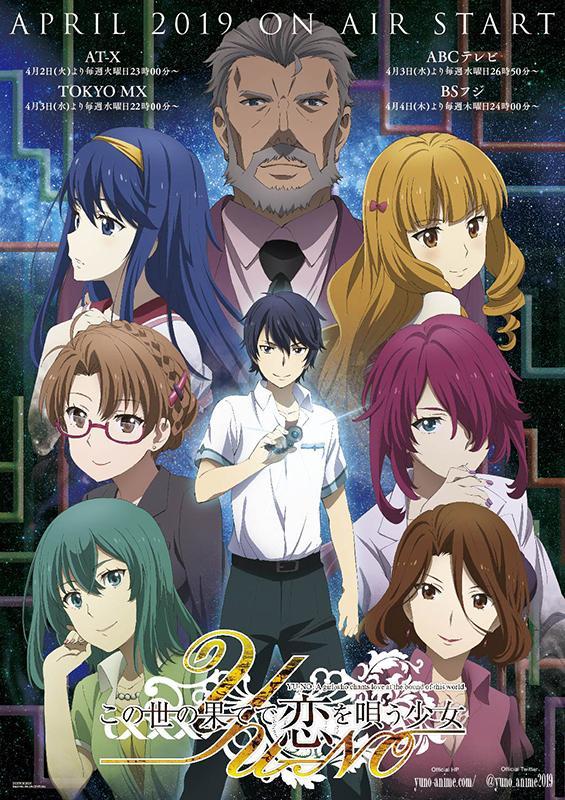
Above: Poster for anime Kori no hate
Dogra Magra exemplifies modern Japanese avant-garde gothic literature.
In the story, the protagonist/narrator wakes up in a hospital with amnesia.
He finds out that he was the subject of an experiment by a now-dead psychiatrist, and the doctors are working to bring back his memories.
It is not clear whether he was a psychotic killer or the victim of a strange psychological experiment, but it is told that he killed his mother and wife and that he inherited his psychotic tendencies from an insane ancestor.
This novel is strongly influenced by Freudian psychoanalysis and through Yumeno’s contacts there, provides considerable historical insight into the development of the study of psychoanalysis at Kyushu Imperial University.
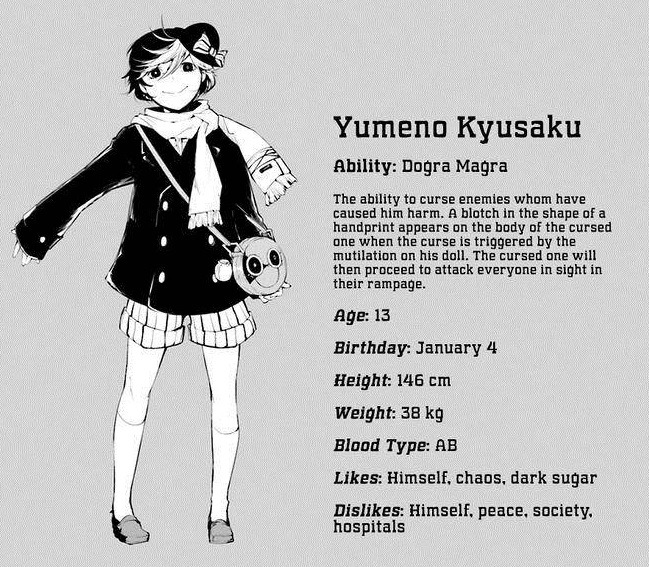
Kyūsaku died of a cerebral hemorrhage in 1936 while talking with a visitor at home.
(It must have been one hell of a conversation!)

Jirō Akagawa (born 1948) is a Japanese novelist born in Fukuoka.

Best known for his humorous mysteries, Akagawa’s first short story, “Ghost Train“, was published in 1976 and went on to win the annually granted All Yomimono New Mystery Writers’ Prize by Bungeishunju, a Japanese literary publishing company.

Other works of his, The Incident in the Bedroom Suburb and Voice from Heaven were later made into anime, while Sailor Suit and Machine Gun was made into a popular live action movie.

His most recognized works to date pertain to his Mike-neko (calico cat) Holmes series.
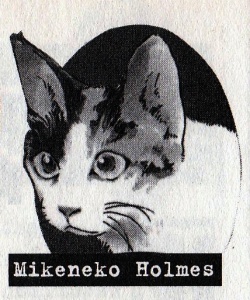
He is extremely prolific:
As of 2013, he had written more than 560 novels in the course of his thirty-year career, over 300 million individual published volumes.
I have neither read (nor seen adaptations) of Jiro’s works, but I would love to know how he is so prolific.
![FULL OF BOOKS Online: Jiro Akagawa [ Mikeneko Holmes to Nakamatachi ] Non Fiction JPN](https://fullofbooks.com.au/images/products/nakamatachihosih.png)
To do justice to Fukuoka, more than one blogpost will be needed.
The beautiful thing about writing about my friends’ adventures is the discovery of both who my friends are and places where I have not been.
I hope, in my own humble way, I can show why the hills of Fukuoka are the backdrop of happiness.

Sources: Wikipedia / Google / The Rough Guide to Japan / Sahoko Kaji, Noriko Hama, Robert Ainsley and Jonathan Rice, Xenophobe’s Guide to the Japanese